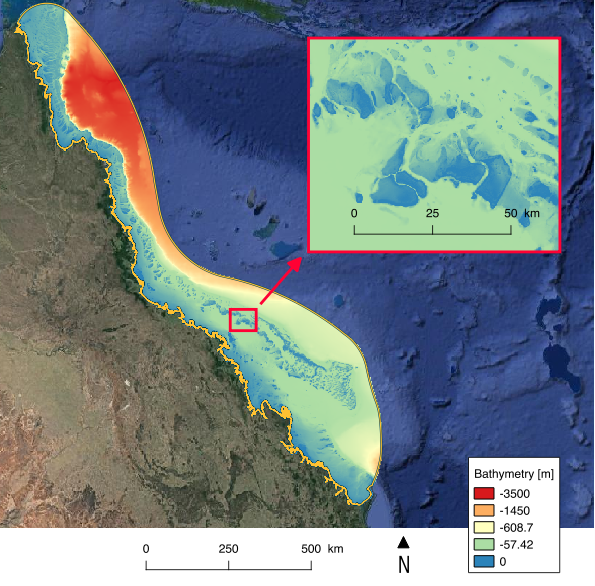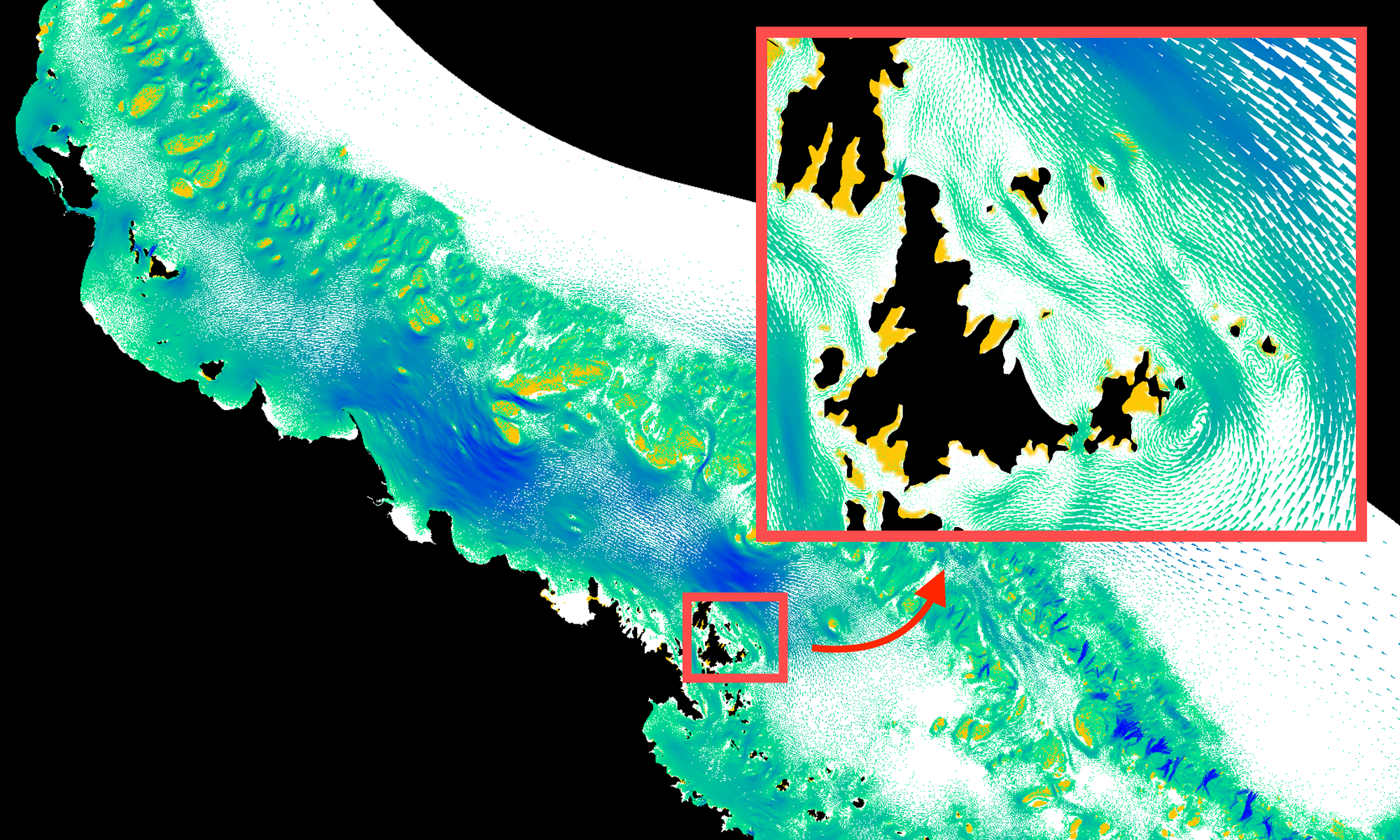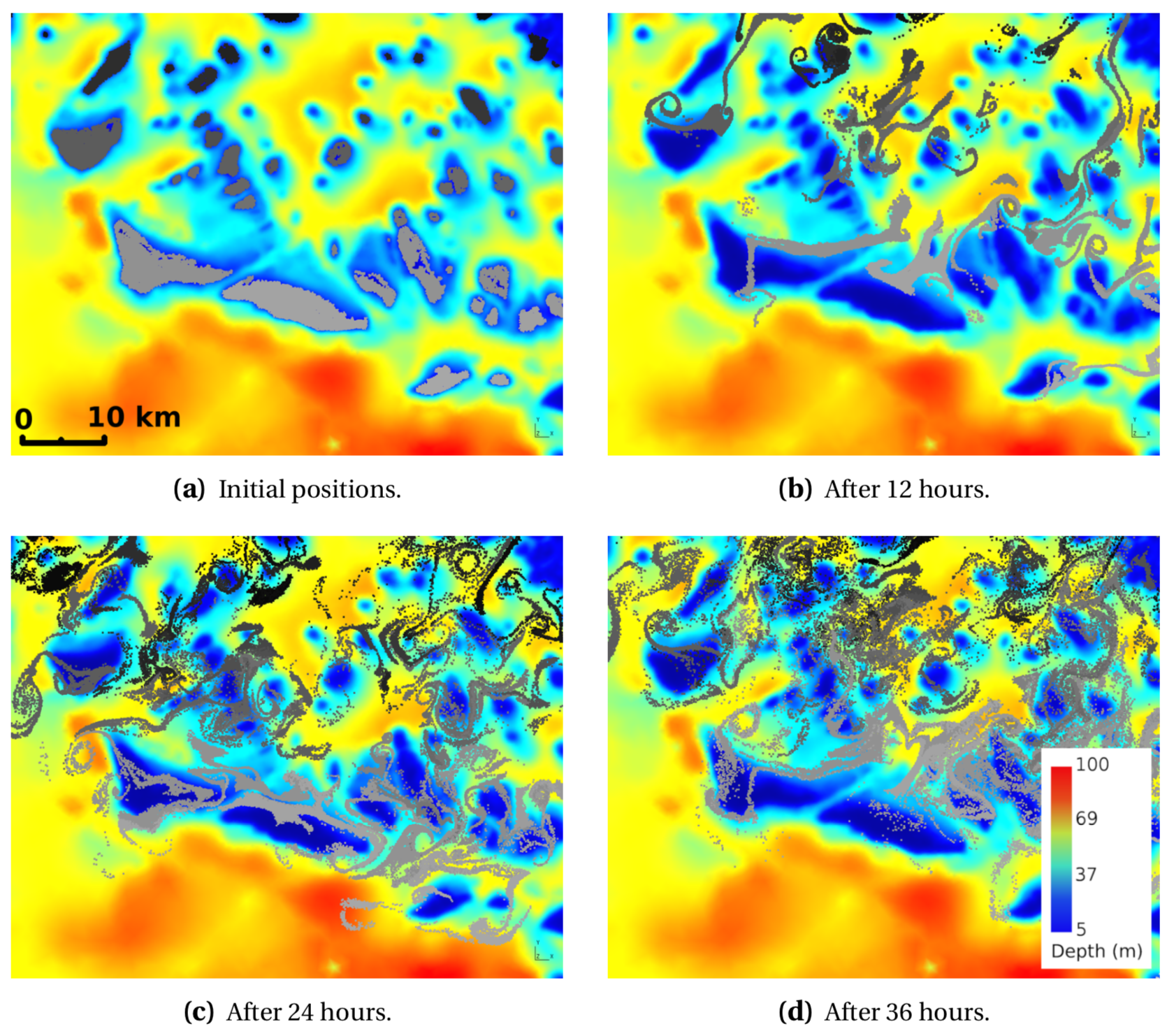The Great Barrier Reef (GBR) is the world’s largest and most complex coral reef ecosystem. Located on the continental shelf off Australia’s north-eastern coast, roughly 2,600 km in length and up to 200 km wide, the GBR is home to a vast array of marine species, including over 600 species of coral and 1600 species of fish. The water currents flowing through the GBR can act to transport marine organisms from one place to another, resulting in the exchange of individuals between populations in different habitats. This is known as connectivity, and is a fundamental process for the dynamics of many marine ecosystems.
Bathymetric map of the Great Barrier Reef over the model’s computational domain. By using SLIM2D, we can simulate the dispersal of marine organisms such as coral larvae or seagrass propagules through the GBR, and in doing so to gain new insights into the connectivity network linking the different habitats of the GBR. SLIM2D can achieve a resolution of about 200m near the >3000 reefs and islands composing the GBR. It can therefore explicitly represent small-scale flow features such as tidal jets and recirculation eddies that have a strong influence on larval transport near the source reefs.
The simulated currents can then be used to model larval transport with the Lagrangian particle tracker. Beside simulating the transport by the currents, this model also simulates the main life-history traits of marine organisms such as mortality, competence loss/acquisition, directed horizontal swimming and settlement onto a a given marine habitat. The Lagrangian particle tracker generates a large connectivity matrix whose elements give the strength of the connectivity between every pair of habitats (such as reefs) in the domain, where the connectivity strength is at this point defined as the number of larvae released over the source habitat which settled onto the sink habitat.
Snapshots showing the dispersal of A. millepora coral larvae around a group of reefs in the southern GBR, as simulated by the SLIM2D. Particles are coloured different shades of grey depending on the reef they were released over, and the bathymetry is shown in colour. The dominant currents were semi-diurnal tides. The presence of eddies in the wakes of reefs can be seen to be acting to retain larvae close to their natal reef. This illustrates the importance of accurately resolving reefs and reef passages. External collaborators
Dr. Severine Choukroune (James Cook University), Dr Kay Critchell (University of Queensland), Dr. Alana Grech (James Cook University) and Dr Eric Wolanski (James Cook University).
To learn more…
778265
gbr
items
1
0
date
desc
1673
https://www.slim-ocean.be/wp-content/plugins/zotpress/
%7B%22status%22%3A%22success%22%2C%22updateneeded%22%3Afalse%2C%22instance%22%3A%22zotpress-bf3fa21fe4a3f338fb805906799a1f83%22%2C%22meta%22%3A%7B%22request_last%22%3A0%2C%22request_next%22%3A0%2C%22used_cache%22%3Atrue%7D%2C%22data%22%3A%5B%7B%22key%22%3A%22Z73QS8B5%22%2C%22library%22%3A%7B%22id%22%3A778265%7D%2C%22meta%22%3A%7B%22creatorSummary%22%3A%22Saint-Amand%20et%20al.%22%2C%22parsedDate%22%3A%222023-06-09%22%2C%22numChildren%22%3A1%7D%2C%22bib%22%3A%22%3Cdiv%20class%3D%5C%22csl-bib-body%5C%22%20style%3D%5C%22line-height%3A%202%3B%20padding-left%3A%201em%3B%20text-indent%3A-1em%3B%5C%22%3E%5Cn%20%20%3Cdiv%20class%3D%5C%22csl-entry%5C%22%3ESaint-Amand%2C%20A.%2C%20Lambrechts%2C%20J.%2C%20%26amp%3B%20Hanert%2C%20E.%20%282023%29.%20Biophysical%20models%20resolution%20affects%20coral%20connectivity%20estimates.%20%3Ci%3EScientific%20Reports%3C%5C%2Fi%3E%2C%20%3Ci%3E13%3C%5C%2Fi%3E%281%29%2C%209414.%20%3Ca%20href%3D%27https%3A%5C%2F%5C%2Fdoi.org%5C%2F10.1038%5C%2Fs41598-023-36158-5%27%3Ehttps%3A%5C%2F%5C%2Fdoi.org%5C%2F10.1038%5C%2Fs41598-023-36158-5%3C%5C%2Fa%3E%3C%5C%2Fdiv%3E%5Cn%3C%5C%2Fdiv%3E%22%2C%22data%22%3A%7B%22itemType%22%3A%22journalArticle%22%2C%22title%22%3A%22Biophysical%20models%20resolution%20affects%20coral%20connectivity%20estimates%22%2C%22creators%22%3A%5B%7B%22creatorType%22%3A%22author%22%2C%22firstName%22%3A%22Antoine%22%2C%22lastName%22%3A%22Saint-Amand%22%7D%2C%7B%22creatorType%22%3A%22author%22%2C%22firstName%22%3A%22Jonathan%22%2C%22lastName%22%3A%22Lambrechts%22%7D%2C%7B%22creatorType%22%3A%22author%22%2C%22firstName%22%3A%22Emmanuel%22%2C%22lastName%22%3A%22Hanert%22%7D%5D%2C%22abstractNote%22%3A%22Abstract%5Cn%20%20%20%20%20%20%20%20%20%20%20%20Estimating%20connectivity%20between%20coral%20reefs%20is%20essential%20to%20inform%20reef%20conservation%20and%20restoration.%20Given%20the%20vastness%20of%20coral%20reef%20ecosystems%2C%20connectivity%20can%20only%20be%20simulated%20with%20biophysical%20models%20whose%20spatial%20resolution%20is%20often%20coarser%20than%20the%20reef%20scale.%20Here%2C%20we%20assess%20the%20impact%20of%20biophysical%20models%20resolution%20on%20connectivity%20estimates%20by%20comparing%20the%20outputs%20of%20five%20different%20setups%20of%20the%20same%20model%20with%20resolutions%20ranging%20from%20250%5Cu00a0m%20to%204%5Cu00a0km.%20We%20show%20that%20increasing%20the%20model%20resolution%20around%20reefs%20yields%20more%20complex%20and%20less%20directional%20dispersal%20patterns.%20With%20a%20fine-resolution%20model%2C%20connectivity%20graphs%20have%20more%20connections%20but%20of%20weaker%20strength.%20The%20resulting%20community%20structure%20therefore%20shows%20larger%20clusters%20of%20well-connected%20reefs.%20Virtual%20larvae%20also%20tend%20to%20stay%20longer%20close%20to%20their%20source%20reef%20with%20a%20fine-resolution%20model%2C%20leading%20to%20an%20increased%20local%20retention%20and%20self-recruitment%20for%20species%20with%20a%20short%20pre-competency%20period.%20Overall%2C%20only%20about%20half%20of%20the%20reefs%20with%20the%20largest%20connectivity%20indicator%20values%20are%20similar%20for%20the%20finest%20and%20coarsest%20resolution%20models.%20Our%20results%20suggest%20that%20reef%20management%20recommendations%20should%20only%20be%20made%20at%20scales%20coarser%20than%20the%20model%20resolution.%20Reef-scale%20recommendations%20can%20hence%20only%20be%20made%20with%20models%20not%20exceeding%20about%20500%5Cu00a0m%20resolution.%22%2C%22date%22%3A%222023-06-09%22%2C%22language%22%3A%22en%22%2C%22DOI%22%3A%2210.1038%5C%2Fs41598-023-36158-5%22%2C%22ISSN%22%3A%222045-2322%22%2C%22url%22%3A%22https%3A%5C%2F%5C%2Fwww.nature.com%5C%2Farticles%5C%2Fs41598-023-36158-5%22%2C%22collections%22%3A%5B%22GJSQZPDC%22%5D%2C%22dateModified%22%3A%222023-06-14T06%3A42%3A46Z%22%7D%7D%2C%7B%22key%22%3A%22KJRUBWX9%22%2C%22library%22%3A%7B%22id%22%3A778265%7D%2C%22meta%22%3A%7B%22creatorSummary%22%3A%22Saint-Amand%20et%20al.%22%2C%22parsedDate%22%3A%222023%22%2C%22numChildren%22%3A1%7D%2C%22bib%22%3A%22%3Cdiv%20class%3D%5C%22csl-bib-body%5C%22%20style%3D%5C%22line-height%3A%202%3B%20padding-left%3A%201em%3B%20text-indent%3A-1em%3B%5C%22%3E%5Cn%20%20%3Cdiv%20class%3D%5C%22csl-entry%5C%22%3ESaint-Amand%2C%20A.%2C%20Lambrechts%2C%20J.%2C%20Thomas%2C%20C.%20J.%2C%20%26amp%3B%20Hanert%2C%20E.%20%282023%29.%20How%20fine%20is%20fine%20enough%3F%20Effect%20of%20mesh%20resolution%20on%20hydrodynamic%20simulations%20in%20coral%20reef%20environments.%20%3Ci%3EOcean%20Modelling%3C%5C%2Fi%3E%2C%20%3Ci%3E186%3C%5C%2Fi%3E%2C%20102254.%20%3Ca%20href%3D%27https%3A%5C%2F%5C%2Fdoi.org%5C%2F10.1016%5C%2Fj.ocemod.2023.102254%27%3Ehttps%3A%5C%2F%5C%2Fdoi.org%5C%2F10.1016%5C%2Fj.ocemod.2023.102254%3C%5C%2Fa%3E%3C%5C%2Fdiv%3E%5Cn%3C%5C%2Fdiv%3E%22%2C%22data%22%3A%7B%22itemType%22%3A%22journalArticle%22%2C%22title%22%3A%22How%20fine%20is%20fine%20enough%3F%20Effect%20of%20mesh%20resolution%20on%20hydrodynamic%20simulations%20in%20coral%20reef%20environments%22%2C%22creators%22%3A%5B%7B%22creatorType%22%3A%22author%22%2C%22firstName%22%3A%22Antoine%22%2C%22lastName%22%3A%22Saint-Amand%22%7D%2C%7B%22creatorType%22%3A%22author%22%2C%22firstName%22%3A%22Jonathan%22%2C%22lastName%22%3A%22Lambrechts%22%7D%2C%7B%22creatorType%22%3A%22author%22%2C%22firstName%22%3A%22Christopher%20J.%22%2C%22lastName%22%3A%22Thomas%22%7D%2C%7B%22creatorType%22%3A%22author%22%2C%22firstName%22%3A%22Emmanuel%22%2C%22lastName%22%3A%22Hanert%22%7D%5D%2C%22abstractNote%22%3A%22Coral%20reef%20environments%20are%20biodiversity%20hotspots%20that%20provide%20many%20services%20to%20coastal%20communities.%20They%20are%20currently%20facing%20an%20increasing%20anthropogenic%20pressure%20that%20jeopardises%20their%20survival.%20Numerical%20ocean%20models%20are%20an%20important%20tool%20to%20understand%20the%20functioning%20of%20coral%20ecosystems%20and%20the%20mechanisms%20ensuring%20their%20resilience.%20However%2C%20simulating%20the%20water%20circulation%20through%20reef%20systems%20is%20challenging%20because%20of%20their%20naturally%20complex%20topography%20and%20bathymetry.%20Many%20ocean%20models%20used%20for%20such%20applications%20have%20a%20spatial%20resolution%20coarser%20than%20the%20scale%20of%20individual%20reefs%2C%20which%20puts%20into%20question%20their%20suitability%20for%20the%20task.%20Here%2C%20we%20assess%20the%20sensitivity%20of%20a%20coastal%20ocean%20model%5Cu2019s%20outputs%20to%20its%20spatial%20resolution%20when%20simulating%20the%20water%20circulation%20in%20the%20entire%20Great%20Barrier%20Reef%20%28Australia%29%2C%20the%20largest%20coral%20reef%20system%20in%20the%20world.%20We%20consider%20the%20same%20model%20with%20five%20different%20resolutions%20near%20reefs%2C%20ranging%20from%20250%20m%20to%204%20km%2C%20and%20compare%20the%20model%20outputs%20at%20different%20locations%20around%20reefs%20and%20in%20the%20open%20ocean.%20We%20also%20simulate%20the%20transport%20of%20passive%20particles%20released%20from%20those%20different%20locations.%20Our%20results%20show%20that%20the%20simulated%20tidal%20signal%20is%20similar%20for%20all%20five%20resolutions.%20However%2C%20strong%20discrepancies%20%28%3E%2010%20cm%5C%2Fs%29%20in%20the%20current%20velocity%20are%20observed%20near%20the%20reefs%20and%20along%20the%20rugged%20coastline.%20When%20using%20a%20coarse-resolution%20model%2C%20the%20amplitude%20of%20the%20currents%20is%20overestimated%20over%20reefs%2C%20and%20underestimated%20between%20them.%20We%20find%20that%20validating%20the%20model%20at%20deep%20water%20mooring%20sites%20is%20not%20sufficient%20to%20ensure%20it%20performs%20well%20close%20to%20reefs.%20Discrepancies%20in%20currents%20lead%20to%20more%20directional%20and%20uniform%20tracer%20dispersal%20patterns%20on%20coarse-resolution%20meshes%20that%20contrast%20with%20the%20more%20dispersive%20patterns%20observed%20on%20fine-resolution%20meshes.%20Those%20differences%20at%20the%20reef%20level%20have%20a%20large%20cumulative%20effect%20when%20simulating%20transport%20processes%20over%20several%20weeks.%20Our%20results%20suggest%20that%20ocean%20circulation%20and%20transport%20simulations%20in%20coral%20reef%20environments%20should%20be%20based%20on%20model%20resolutions%20finer%20than%20the%20reef%20scale%2C%20which%20generally%20means%20a%20maximum%20resolution%20of%20about%20250%5Cu2013500%20m.%22%2C%22date%22%3A%2212%5C%2F2023%22%2C%22language%22%3A%22en%22%2C%22DOI%22%3A%2210.1016%5C%2Fj.ocemod.2023.102254%22%2C%22ISSN%22%3A%2214635003%22%2C%22url%22%3A%22https%3A%5C%2F%5C%2Flinkinghub.elsevier.com%5C%2Fretrieve%5C%2Fpii%5C%2FS1463500323000951%22%2C%22collections%22%3A%5B%22GJSQZPDC%22%5D%2C%22dateModified%22%3A%222023-09-07T11%3A09%3A50Z%22%7D%7D%2C%7B%22key%22%3A%22IZBNJ472%22%2C%22library%22%3A%7B%22id%22%3A778265%7D%2C%22meta%22%3A%7B%22creatorSummary%22%3A%22Saint-Amand%20et%20al.%22%2C%22parsedDate%22%3A%222022-04-22%22%2C%22numChildren%22%3A1%7D%2C%22bib%22%3A%22%3Cdiv%20class%3D%5C%22csl-bib-body%5C%22%20style%3D%5C%22line-height%3A%202%3B%20padding-left%3A%201em%3B%20text-indent%3A-1em%3B%5C%22%3E%5Cn%20%20%3Cdiv%20class%3D%5C%22csl-entry%5C%22%3ESaint-Amand%2C%20A.%2C%20Grech%2C%20A.%2C%20Choukroun%2C%20S.%2C%20%26amp%3B%20Hanert%2C%20E.%20%282022%29.%20Quantifying%20the%20environmental%20impact%20of%20a%20major%20coal%20mine%20project%20on%20the%20adjacent%20Great%20Barrier%20Reef%20ecosystems.%20%3Ci%3EMarine%20Pollution%20Bulletin%3C%5C%2Fi%3E%2C%20%3Ci%3E179%3C%5C%2Fi%3E%2C%20113556.%20%3Ca%20href%3D%27https%3A%5C%2F%5C%2Fdoi.org%5C%2Fj.marpolbul.2022.113656%27%3Ehttps%3A%5C%2F%5C%2Fdoi.org%5C%2Fj.marpolbul.2022.113656%3C%5C%2Fa%3E%3C%5C%2Fdiv%3E%5Cn%3C%5C%2Fdiv%3E%22%2C%22data%22%3A%7B%22itemType%22%3A%22journalArticle%22%2C%22title%22%3A%22Quantifying%20the%20environmental%20impact%20of%20a%20major%20coal%20mine%20project%20on%20the%20adjacent%20Great%20Barrier%20Reef%20ecosystems%22%2C%22creators%22%3A%5B%7B%22creatorType%22%3A%22author%22%2C%22firstName%22%3A%22Antoine%22%2C%22lastName%22%3A%22Saint-Amand%22%7D%2C%7B%22creatorType%22%3A%22author%22%2C%22firstName%22%3A%22Alana%22%2C%22lastName%22%3A%22Grech%22%7D%2C%7B%22creatorType%22%3A%22author%22%2C%22firstName%22%3A%22Severine%22%2C%22lastName%22%3A%22Choukroun%22%7D%2C%7B%22creatorType%22%3A%22author%22%2C%22firstName%22%3A%22Emmanuel%22%2C%22lastName%22%3A%22Hanert%22%7D%5D%2C%22abstractNote%22%3A%22A%20major%20coal%20mine%20project%20in%20Queensland%2C%20Australia%2C%20is%20currently%20under%20review.%20It%20is%20planned%20to%20be%20located%20about%2010%20km%20away%20from%20the%20Great%20Barrier%20Reef%20World%20Heritage%20Area%20%28GBRWHA%29.%20Sediment%20dispersal%20patterns%20and%20their%20impact%20on%20marine%20ecosystems%20have%20not%20been%20properly%20assessed%20yet.%20Here%2C%20we%20simulate%20the%20dispersal%20of%20different%20sediment%20types%20with%20a%20high-resolution%20ocean%20model%2C%20and%20derive%20their%20environmental%20footprint.%20We%20show%20that%20sediments%20finer%20than%2032%20%5Cu03bcm%20could%20reach%20dense%20seagrass%20meadows%20and%20a%20dugong%20sanctuary%20within%20a%20few%20weeks.%20The%20intense%20tidal%20circulation%20leads%20to%20non-isotropic%20and%20long-distance%20sediment%20dispersal%20patterns%20along%20the%20coast.%20Our%20results%20suggest%20that%20the%20sediments%20released%20by%20this%20project%20will%20not%20be%20quickly%20mixed%20but%20rather%20be%20concen%5Cu00ad%20trated%20where%20the%20most%20valuable%20ecosystems%20are%20located.%20If%20accepted%2C%20this%20coal%20mine%20could%20therefore%20have%20a%20farreaching%20impact%20on%20the%20GBRWHA%20and%20its%20iconic%20marine%20species.%22%2C%22date%22%3A%222022-04-22%22%2C%22language%22%3A%22en%22%2C%22DOI%22%3A%22j.marpolbul.2022.113656%22%2C%22ISSN%22%3A%22%22%2C%22url%22%3A%22https%3A%5C%2F%5C%2Fdoi.org%5C%2F10.1016%5C%2Fj.marpolbul.2022.113656%22%2C%22collections%22%3A%5B%22GJSQZPDC%22%5D%2C%22dateModified%22%3A%222022-04-26T07%3A49%3A42Z%22%7D%7D%2C%7B%22key%22%3A%224SICIZ87%22%2C%22library%22%3A%7B%22id%22%3A778265%7D%2C%22meta%22%3A%7B%22lastModifiedByUser%22%3A%7B%22id%22%3A5103066%2C%22username%22%3A%22ehanert%22%2C%22name%22%3A%22%22%2C%22links%22%3A%7B%22alternate%22%3A%7B%22href%22%3A%22https%3A%5C%2F%5C%2Fwww.zotero.org%5C%2Fehanert%22%2C%22type%22%3A%22text%5C%2Fhtml%22%7D%7D%7D%2C%22creatorSummary%22%3A%22Schlaefer%20et%20al.%22%2C%22parsedDate%22%3A%222022%22%2C%22numChildren%22%3A1%7D%2C%22bib%22%3A%22%3Cdiv%20class%3D%5C%22csl-bib-body%5C%22%20style%3D%5C%22line-height%3A%202%3B%20padding-left%3A%201em%3B%20text-indent%3A-1em%3B%5C%22%3E%5Cn%20%20%3Cdiv%20class%3D%5C%22csl-entry%5C%22%3ESchlaefer%2C%20J.%2C%20Carter%2C%20A.%2C%20Choukroun%2C%20S.%2C%20Coles%2C%20R.%2C%20Critchell%2C%20K.%2C%20Lambrechts%2C%20J.%2C%20Rasheed%2C%20M.%2C%20Tol%2C%20S.%2C%20%26amp%3B%20Grech%2C%20A.%20%282022%29.%20Marine%20plant%20dispersal%20and%20connectivity%20measures%20differ%20in%20their%20sensitivity%20to%20biophysical%20model%20parameters.%20%3Ci%3EEnvironmental%20Modelling%20%26amp%3B%20Software%3C%5C%2Fi%3E%2C%20%3Ci%3E149%3C%5C%2Fi%3E%2C%20105313.%20%3Ca%20href%3D%27https%3A%5C%2F%5C%2Fdoi.org%5C%2F10.1016%5C%2Fj.envsoft.2022.105313%27%3Ehttps%3A%5C%2F%5C%2Fdoi.org%5C%2F10.1016%5C%2Fj.envsoft.2022.105313%3C%5C%2Fa%3E%3C%5C%2Fdiv%3E%5Cn%3C%5C%2Fdiv%3E%22%2C%22data%22%3A%7B%22itemType%22%3A%22journalArticle%22%2C%22title%22%3A%22Marine%20plant%20dispersal%20and%20connectivity%20measures%20differ%20in%20their%20sensitivity%20to%20biophysical%20model%20parameters%22%2C%22creators%22%3A%5B%7B%22creatorType%22%3A%22author%22%2C%22firstName%22%3A%22Jodie%22%2C%22lastName%22%3A%22Schlaefer%22%7D%2C%7B%22creatorType%22%3A%22author%22%2C%22firstName%22%3A%22Alexandra%22%2C%22lastName%22%3A%22Carter%22%7D%2C%7B%22creatorType%22%3A%22author%22%2C%22firstName%22%3A%22Severine%22%2C%22lastName%22%3A%22Choukroun%22%7D%2C%7B%22creatorType%22%3A%22author%22%2C%22firstName%22%3A%22Robert%22%2C%22lastName%22%3A%22Coles%22%7D%2C%7B%22creatorType%22%3A%22author%22%2C%22firstName%22%3A%22Kay%22%2C%22lastName%22%3A%22Critchell%22%7D%2C%7B%22creatorType%22%3A%22author%22%2C%22firstName%22%3A%22Jonathan%22%2C%22lastName%22%3A%22Lambrechts%22%7D%2C%7B%22creatorType%22%3A%22author%22%2C%22firstName%22%3A%22Michael%22%2C%22lastName%22%3A%22Rasheed%22%7D%2C%7B%22creatorType%22%3A%22author%22%2C%22firstName%22%3A%22Samantha%22%2C%22lastName%22%3A%22Tol%22%7D%2C%7B%22creatorType%22%3A%22author%22%2C%22firstName%22%3A%22Alana%22%2C%22lastName%22%3A%22Grech%22%7D%5D%2C%22abstractNote%22%3A%22Biophysical%20models%20simulate%20dispersal%20and%20connectivity%20in%20marine%20environments%20by%20combining%20numerical%20models%20that%20represent%20water%20circulation%20with%20biological%20parameters%20that%20define%20the%20attributes%20of%20species.%20The%20effects%20of%20parameters%2C%20such%20as%20the%20number%20of%20particles%20released%20to%20simulate%20the%20trajectories%20of%20individual%20organisms%2C%20is%20potentially%20large%20but%20rarely%20tested.%20We%20present%20a%20framework%20to%20measure%20the%20optimal%20number%20of%20particles%20required%20to%20capture%20variability%20in%20dispersal%20and%20connectivity%20of%20the%20marine%20plants%2C%20seagrasses.%20We%20found%20that%20the%20number%20of%20optimal%20release%20particles%20per%20element%20%28or%20grid%20cell%29%20for%20dispersal%20estimates%20varied%20with%20seagrass%20habitat%20type%2C%20season%2C%20and%20physical%20parameters%20of%20the%20modelled%20propagules%20%28i.e.%2C%20wind%20drag%29.%20Connectivity%20metrics%20were%20comparatively%20much%20less%20sensitive%2C%20requiring%20lower%20particle%20numbers%20to%20achieve%20stable%20results.%20We%20provide%20guidance%20on%20important%20factors%20to%20consider%20when%20determining%20the%20optimal%20number%20of%20particles%20required%20to%20robustly%20predict%20dispersal%20and%20connectivity%20in%20biophysical%20models%20of%20marine%20plants.%22%2C%22date%22%3A%2203%5C%2F2022%22%2C%22language%22%3A%22en%22%2C%22DOI%22%3A%2210.1016%5C%2Fj.envsoft.2022.105313%22%2C%22ISSN%22%3A%2213648152%22%2C%22url%22%3A%22https%3A%5C%2F%5C%2Flinkinghub.elsevier.com%5C%2Fretrieve%5C%2Fpii%5C%2FS1364815222000196%22%2C%22collections%22%3A%5B%22GJSQZPDC%22%5D%2C%22dateModified%22%3A%222022-01-23T15%3A02%3A23Z%22%7D%7D%2C%7B%22key%22%3A%22GJ35RBBW%22%2C%22library%22%3A%7B%22id%22%3A778265%7D%2C%22meta%22%3A%7B%22lastModifiedByUser%22%3A%7B%22id%22%3A5103066%2C%22username%22%3A%22ehanert%22%2C%22name%22%3A%22%22%2C%22links%22%3A%7B%22alternate%22%3A%7B%22href%22%3A%22https%3A%5C%2F%5C%2Fwww.zotero.org%5C%2Fehanert%22%2C%22type%22%3A%22text%5C%2Fhtml%22%7D%7D%7D%2C%22creatorSummary%22%3A%22Wolanski%20and%20Hopper%22%2C%22parsedDate%22%3A%222022%22%2C%22numChildren%22%3A1%7D%2C%22bib%22%3A%22%3Cdiv%20class%3D%5C%22csl-bib-body%5C%22%20style%3D%5C%22line-height%3A%202%3B%20padding-left%3A%201em%3B%20text-indent%3A-1em%3B%5C%22%3E%5Cn%20%20%3Cdiv%20class%3D%5C%22csl-entry%5C%22%3EWolanski%2C%20E.%2C%20%26amp%3B%20Hopper%2C%20C.%20%282022%29.%20Dams%20and%20climate%20change%20accelerate%20channel%20avulsion%20and%20coastal%20erosion%20and%20threaten%20Ramsar-listed%20wetlands%20in%20the%20largest%20Great%20Barrier%20Reef%20watershed.%20%3Ci%3EEcohydrology%20%26amp%3B%20Hydrobiology%3C%5C%2Fi%3E%2C%20S1642359322000015.%20%3Ca%20href%3D%27https%3A%5C%2F%5C%2Fdoi.org%5C%2F10.1016%5C%2Fj.ecohyd.2022.01.001%27%3Ehttps%3A%5C%2F%5C%2Fdoi.org%5C%2F10.1016%5C%2Fj.ecohyd.2022.01.001%3C%5C%2Fa%3E%3C%5C%2Fdiv%3E%5Cn%3C%5C%2Fdiv%3E%22%2C%22data%22%3A%7B%22itemType%22%3A%22journalArticle%22%2C%22title%22%3A%22Dams%20and%20climate%20change%20accelerate%20channel%20avulsion%20and%20coastal%20erosion%20and%20threaten%20Ramsar-listed%20wetlands%20in%20the%20largest%20Great%20Barrier%20Reef%20watershed%22%2C%22creators%22%3A%5B%7B%22creatorType%22%3A%22author%22%2C%22firstName%22%3A%22Eric%22%2C%22lastName%22%3A%22Wolanski%22%7D%2C%7B%22creatorType%22%3A%22author%22%2C%22firstName%22%3A%22Christopher%22%2C%22lastName%22%3A%22Hopper%22%7D%5D%2C%22abstractNote%22%3A%22%22%2C%22date%22%3A%221%5C%2F2022%22%2C%22language%22%3A%22en%22%2C%22DOI%22%3A%2210.1016%5C%2Fj.ecohyd.2022.01.001%22%2C%22ISSN%22%3A%2216423593%22%2C%22url%22%3A%22https%3A%5C%2F%5C%2Flinkinghub.elsevier.com%5C%2Fretrieve%5C%2Fpii%5C%2FS1642359322000015%22%2C%22collections%22%3A%5B%22GJSQZPDC%22%5D%2C%22dateModified%22%3A%222022-01-23T15%3A03%3A11Z%22%7D%7D%2C%7B%22key%22%3A%22JXNVVP3L%22%2C%22library%22%3A%7B%22id%22%3A778265%7D%2C%22meta%22%3A%7B%22creatorSummary%22%3A%22Figueiredo%20et%20al.%22%2C%22parsedDate%22%3A%222022%22%2C%22numChildren%22%3A1%7D%2C%22bib%22%3A%22%3Cdiv%20class%3D%5C%22csl-bib-body%5C%22%20style%3D%5C%22line-height%3A%202%3B%20padding-left%3A%201em%3B%20text-indent%3A-1em%3B%5C%22%3E%5Cn%20%20%3Cdiv%20class%3D%5C%22csl-entry%5C%22%3EFigueiredo%2C%20J.%2C%20Thomas%2C%20C.%20J.%2C%20Deleersnijder%2C%20E.%2C%20Lambrechts%2C%20J.%2C%20Baird%2C%20A.%20H.%2C%20Connolly%2C%20S.%20R.%2C%20%26amp%3B%20Hanert%2C%20E.%20%282022%29.%20Global%20warming%20decreases%20connectivity%20among%20coral%20populations.%20%3Ci%3ENature%20Climate%20Change%3C%5C%2Fi%3E%2C%20%3Ci%3E12%3C%5C%2Fi%3E%281%29%2C%2083%26%23x2013%3B87.%20%3Ca%20href%3D%27https%3A%5C%2F%5C%2Fdoi.org%5C%2F10.1038%5C%2Fs41558-021-01248-7%27%3Ehttps%3A%5C%2F%5C%2Fdoi.org%5C%2F10.1038%5C%2Fs41558-021-01248-7%3C%5C%2Fa%3E%3C%5C%2Fdiv%3E%5Cn%3C%5C%2Fdiv%3E%22%2C%22data%22%3A%7B%22itemType%22%3A%22journalArticle%22%2C%22title%22%3A%22Global%20warming%20decreases%20connectivity%20among%20coral%20populations%22%2C%22creators%22%3A%5B%7B%22creatorType%22%3A%22author%22%2C%22firstName%22%3A%22Joana%22%2C%22lastName%22%3A%22Figueiredo%22%7D%2C%7B%22creatorType%22%3A%22author%22%2C%22firstName%22%3A%22Christopher%20J.%22%2C%22lastName%22%3A%22Thomas%22%7D%2C%7B%22creatorType%22%3A%22author%22%2C%22firstName%22%3A%22Eric%22%2C%22lastName%22%3A%22Deleersnijder%22%7D%2C%7B%22creatorType%22%3A%22author%22%2C%22firstName%22%3A%22Jonathan%22%2C%22lastName%22%3A%22Lambrechts%22%7D%2C%7B%22creatorType%22%3A%22author%22%2C%22firstName%22%3A%22Andrew%20H.%22%2C%22lastName%22%3A%22Baird%22%7D%2C%7B%22creatorType%22%3A%22author%22%2C%22firstName%22%3A%22Sean%20R.%22%2C%22lastName%22%3A%22Connolly%22%7D%2C%7B%22creatorType%22%3A%22author%22%2C%22firstName%22%3A%22Emmanuel%22%2C%22lastName%22%3A%22Hanert%22%7D%5D%2C%22abstractNote%22%3A%22%22%2C%22date%22%3A%2201%5C%2F2022%22%2C%22language%22%3A%22en%22%2C%22DOI%22%3A%2210.1038%5C%2Fs41558-021-01248-7%22%2C%22ISSN%22%3A%221758-678X%2C%201758-6798%22%2C%22url%22%3A%22https%3A%5C%2F%5C%2Fwww.nature.com%5C%2Farticles%5C%2Fs41558-021-01248-7%22%2C%22collections%22%3A%5B%22GJSQZPDC%22%5D%2C%22dateModified%22%3A%222022-02-06T10%3A42%3A17Z%22%7D%7D%2C%7B%22key%22%3A%22KR37PPAU%22%2C%22library%22%3A%7B%22id%22%3A778265%7D%2C%22meta%22%3A%7B%22creatorSummary%22%3A%22Wolanski%20and%20Lambrechts%22%2C%22parsedDate%22%3A%222020%22%2C%22numChildren%22%3A1%7D%2C%22bib%22%3A%22%3Cdiv%20class%3D%5C%22csl-bib-body%5C%22%20style%3D%5C%22line-height%3A%202%3B%20padding-left%3A%201em%3B%20text-indent%3A-1em%3B%5C%22%3E%5Cn%20%20%3Cdiv%20class%3D%5C%22csl-entry%5C%22%3EWolanski%2C%20E.%2C%20%26amp%3B%20Lambrechts%2C%20J.%20%282020%29.%20The%20net%20water%20circulation%20in%20the%20far%20Northern%20Great%20Barrier%20Reef.%20%3Ci%3EEstuarine%2C%20Coastal%20and%20Shelf%20Science%3C%5C%2Fi%3E%2C%20%3Ci%3E235%3C%5C%2Fi%3E%2C%20106569.%20%3Ca%20href%3D%27https%3A%5C%2F%5C%2Fdoi.org%5C%2F10.1016%5C%2Fj.ecss.2019.106569%27%3Ehttps%3A%5C%2F%5C%2Fdoi.org%5C%2F10.1016%5C%2Fj.ecss.2019.106569%3C%5C%2Fa%3E%3C%5C%2Fdiv%3E%5Cn%3C%5C%2Fdiv%3E%22%2C%22data%22%3A%7B%22itemType%22%3A%22journalArticle%22%2C%22title%22%3A%22The%20net%20water%20circulation%20in%20the%20far%20Northern%20Great%20Barrier%20Reef%22%2C%22creators%22%3A%5B%7B%22creatorType%22%3A%22author%22%2C%22firstName%22%3A%22Eric%22%2C%22lastName%22%3A%22Wolanski%22%7D%2C%7B%22creatorType%22%3A%22author%22%2C%22firstName%22%3A%22Jonathan%22%2C%22lastName%22%3A%22Lambrechts%22%7D%5D%2C%22abstractNote%22%3A%22The%20500%20km%20long%20Far%20Northern%20Great%20Barrier%20Reef%20%28FNGBR%29%20is%20a%20semi-enclosed%20sea%20with%20little%20connectivity%20with%20the%20rest%20of%20the%20GBR%20further%20South.%20Its%20mean%20circulation%20is%20controlled%20by%20the%20prevailing%20southeasterly%20%28northwestward%29%20wind%20that%20generates%20a%20wind-driven%20mean%20longshore%20flow%20that%20is%20enabled%20by%20an%20inflow%20of%20oceanic%20water%20in%20the%20South.%20From%20an%20examination%20of%20single-point%2C%20mid-depth%20current%20meter%20data%20at%20ten%20sites%20over%20one%20year%2C%20it%20appears%20that%20there%20is%20no%20net%20current%20during%20calm%20weather%2C%20which%20implies%20that%20the%20northward%20North%20Queensland%20Coastal%20Current%20in%20the%20adjoining%20Coral%20Sea%20does%20not%20intrude%20in%20the%20FNGBR.%20Only%20about%2020%5Cu201340%25%20of%20the%20wind-driven%20longshore%20transport%20continues%20northward%20to%20exit%20the%20FNGBR%20through%20Torres%20Strait%20because%20of%20blockage%20by%20reefs%2C%20shoals%20and%20islands%20and%20by%20the%20tidal%20friction%20effect%20in%20shallow%20waters.%20The%20remaining%2060%5Cu201380%25%20of%20the%20flow%20appears%20to%20be%20deflected%20seaward%20to%20the%20Coral%20Sea%20in%20the%20North%2C%20an%20observation%20that%20appears%20to%20be%20supported%20by%20oceanographic%20modelling.%20This%20situation%20differs%20from%20that%20in%20the%20central%20and%20southern%20Great%20Barrier%20Reef%20where%20the%20southward%20flowing%20East%20Australian%20Current%20intrudes%20on%20the%20shelf%20and%20generates%20a%20net%20current%20even%20during%20calm%20weather.%22%2C%22date%22%3A%2204%5C%2F2020%22%2C%22language%22%3A%22en%22%2C%22DOI%22%3A%2210.1016%5C%2Fj.ecss.2019.106569%22%2C%22ISSN%22%3A%2202727714%22%2C%22url%22%3A%22https%3A%5C%2F%5C%2Flinkinghub.elsevier.com%5C%2Fretrieve%5C%2Fpii%5C%2FS0272771419306122%22%2C%22collections%22%3A%5B%22GJSQZPDC%22%5D%2C%22dateModified%22%3A%222021-07-14T06%3A59%3A20Z%22%7D%7D%2C%7B%22key%22%3A%22XAL5VEBV%22%2C%22library%22%3A%7B%22id%22%3A778265%7D%2C%22meta%22%3A%7B%22creatorSummary%22%3A%22Schlaefer%20et%20al.%22%2C%22parsedDate%22%3A%222018-05-31%22%2C%22numChildren%22%3A1%7D%2C%22bib%22%3A%22%3Cdiv%20class%3D%5C%22csl-bib-body%5C%22%20style%3D%5C%22line-height%3A%202%3B%20padding-left%3A%201em%3B%20text-indent%3A-1em%3B%5C%22%3E%5Cn%20%20%3Cdiv%20class%3D%5C%22csl-entry%5C%22%3ESchlaefer%2C%20J.%20A.%2C%20Wolanski%2C%20E.%2C%20Lambrechts%2C%20J.%2C%20%26amp%3B%20Kingsford%2C%20M.%20J.%20%282018%29.%20Wind%20Conditions%20on%20the%20Great%20Barrier%20Reef%20Influenced%20the%20Recruitment%20of%20Snapper%20%28Lutjanus%20carponotatus%29.%20%3Ci%3EFrontiers%20in%20Marine%20Science%3C%5C%2Fi%3E%2C%20%3Ci%3E5%3C%5C%2Fi%3E.%20%3Ca%20href%3D%27https%3A%5C%2F%5C%2Fdoi.org%5C%2F10.3389%5C%2Ffmars.2018.00193%27%3Ehttps%3A%5C%2F%5C%2Fdoi.org%5C%2F10.3389%5C%2Ffmars.2018.00193%3C%5C%2Fa%3E%3C%5C%2Fdiv%3E%5Cn%3C%5C%2Fdiv%3E%22%2C%22data%22%3A%7B%22itemType%22%3A%22journalArticle%22%2C%22title%22%3A%22Wind%20Conditions%20on%20the%20Great%20Barrier%20Reef%20Influenced%20the%20Recruitment%20of%20Snapper%20%28Lutjanus%20carponotatus%29%22%2C%22creators%22%3A%5B%7B%22creatorType%22%3A%22author%22%2C%22firstName%22%3A%22Jodie%20A.%22%2C%22lastName%22%3A%22Schlaefer%22%7D%2C%7B%22creatorType%22%3A%22author%22%2C%22firstName%22%3A%22Eric%22%2C%22lastName%22%3A%22Wolanski%22%7D%2C%7B%22creatorType%22%3A%22author%22%2C%22firstName%22%3A%22Jonathan%22%2C%22lastName%22%3A%22Lambrechts%22%7D%2C%7B%22creatorType%22%3A%22author%22%2C%22firstName%22%3A%22Michael%20J.%22%2C%22lastName%22%3A%22Kingsford%22%7D%5D%2C%22abstractNote%22%3A%22Most%20coral%20reef%20%5Cufb01shes%20have%20a%20pelagic%20larval%20stage%20before%20recruiting%20to%20reefs.%20The%20survival%20of%20larvae%20and%20their%20subsequent%20recruitment%20can%20drive%20the%20dynamics%20of%20reef%20populations.%20Here%20we%20show%20that%20the%20recruitment%20of%20the%20snapper%20Lutjanus%20carponotatus%20to%20One%20Tree%20Island%20in%20the%20Capricorn%20Bunker%20Group%2C%20in%20the%20southern%20Great%20Barrier%20Reef%2C%20was%20highly%20variable%20over%2023%20years.%20We%20predicted%20that%20the%20currents%20in%20the%20Capricorn%20Bunker%20Group%2C%20including%20their%20wind%20driven%20components%20and%20the%20Capricorn%20Eddy%20%28a%20nearby%20transient%20oceanic%20eddy%29%2C%20would%20affect%20patterns%20of%20recruitment.%20A%20biophysical%20model%20was%20used%20to%20investigate%20this%20prediction.%20L.%20carponotatus%20were%20collected%20from%20One%20Tree%20Island%20and%20the%20dates%20when%20they%20were%20in%20the%20plankton%20as%20larvae%20were%20determined%20from%20their%20otoliths.%20The%20winds%20present%20during%20the%20pelagic%20phases%20of%20the%20%5Cufb01sh%20were%20examined%3B%20they%20were%20found%20to%20have%20survived%20either%20longshore%20%28SSE%29%20winds%20that%20induced%20little%20cross%20shelf%20movement%20in%20the%20larval%20plume%20or%20cross%20shelf%20%28ENE%29%20winds%20that%20induced%20little%20longshore%20movement.%20The%20unidirectional%20transportation%20of%20the%20larval%20plume%20in%20these%20conditions%20was%20favorable%20for%20recruitment%20as%20it%20kept%20the%20plume%20concentrated%20in%20the%20Capricorn%20Bunker%20Group.%20These%20winds%20were%20more%20prevalent%20in%20the%20periods%20of%20peak%20L.%20carponotatus%20production%20that%20preceded%20high%20recruitment.%20Dispersal%20under%20average%20winds%20%286.2%20m%20s%5Cu22121%20from%20the%20prevailing%20ESE%29%20and%20strong%20winds%20%28velocity%201.5%20times%20average%29%2C%20with%20and%20without%20the%20Capricorn%20Eddy%2C%20was%20also%20modeled.%20Each%20of%20these%20combinations%20were%20less%20favorable%20for%20recruitment%20than%20the%20longshore%20and%20cross%20shelf%20winds%20larval%20L.%20carponotatus%20survived%20before%20reaching%20OTI.%20The%20larval%20plume%20was%20comparatively%20less%20concentrated%20in%20the%20Capricorn%20Bunker%20Group%20under%20average%20winds.%20Strong%20winds%20transported%20the%20larval%20plume%20far%20longshore%2C%20to%20the%20NW%2C%20away%20from%20the%20Capricorn%20Bunker%20Group%2C%20while%20the%20Capricorn%20Eddy%20transported%20larvae%20seaward%20into%20oceanic%20waters.%20Larval%20swimming%20could%20counteract%20these%20dispersive%20forces%3B%20however%2C%20signi%5Cufb01cant%20dispersion%20had%20occurred%20before%20larvae%20developed%20strong%20swimming%20and%20orientation%20abilities.%20This%20study%20provides%20a%20physical%20proxy%20for%20the%20recruitment%20of%20snapper.%20Further%2C%20we%20have%20demonstrated%20that%20great%20insights%20into%20recruitment%20variability%20can%20be%20gained%20through%20determining%20the%20speci%5Cufb01c%20conditions%20experienced%20by%20survivors.%22%2C%22date%22%3A%222018-5-31%22%2C%22language%22%3A%22en%22%2C%22DOI%22%3A%2210.3389%5C%2Ffmars.2018.00193%22%2C%22ISSN%22%3A%222296-7745%22%2C%22url%22%3A%22https%3A%5C%2F%5C%2Fwww.frontiersin.org%5C%2Farticle%5C%2F10.3389%5C%2Ffmars.2018.00193%5C%2Ffull%22%2C%22collections%22%3A%5B%22GJSQZPDC%22%5D%2C%22dateModified%22%3A%222019-09-22T07%3A42%3A24Z%22%7D%7D%2C%7B%22key%22%3A%22WDMPW6JU%22%2C%22library%22%3A%7B%22id%22%3A778265%7D%2C%22meta%22%3A%7B%22creatorSummary%22%3A%22Grech%20et%20al.%22%2C%22parsedDate%22%3A%222018%22%2C%22numChildren%22%3A1%7D%2C%22bib%22%3A%22%3Cdiv%20class%3D%5C%22csl-bib-body%5C%22%20style%3D%5C%22line-height%3A%202%3B%20padding-left%3A%201em%3B%20text-indent%3A-1em%3B%5C%22%3E%5Cn%20%20%3Cdiv%20class%3D%5C%22csl-entry%5C%22%3EGrech%2C%20A.%2C%20Hanert%2C%20E.%2C%20McKenzie%2C%20L.%2C%20Rasheed%2C%20M.%2C%20Thomas%2C%20C.%2C%20Tol%2C%20S.%2C%20Wang%2C%20M.%2C%20Waycott%2C%20M.%2C%20Wolter%2C%20J.%2C%20%26amp%3B%20Coles%2C%20R.%20%282018%29.%20Predicting%20the%20cumulative%20effect%20of%20multiple%20disturbances%20on%20seagrass%20connectivity.%20%3Ci%3EGlobal%20Change%20Biology%3C%5C%2Fi%3E%2C%20%3Ci%3E24%3C%5C%2Fi%3E%287%29%2C%203093%26%23x2013%3B3104.%20%3Ca%20href%3D%27https%3A%5C%2F%5C%2Fdoi.org%5C%2F10.1111%5C%2Fgcb.14127%27%3Ehttps%3A%5C%2F%5C%2Fdoi.org%5C%2F10.1111%5C%2Fgcb.14127%3C%5C%2Fa%3E%3C%5C%2Fdiv%3E%5Cn%3C%5C%2Fdiv%3E%22%2C%22data%22%3A%7B%22itemType%22%3A%22journalArticle%22%2C%22title%22%3A%22Predicting%20the%20cumulative%20effect%20of%20multiple%20disturbances%20on%20seagrass%20connectivity%22%2C%22creators%22%3A%5B%7B%22creatorType%22%3A%22author%22%2C%22firstName%22%3A%22Alana%22%2C%22lastName%22%3A%22Grech%22%7D%2C%7B%22creatorType%22%3A%22author%22%2C%22firstName%22%3A%22Emmanuel%22%2C%22lastName%22%3A%22Hanert%22%7D%2C%7B%22creatorType%22%3A%22author%22%2C%22firstName%22%3A%22Len%22%2C%22lastName%22%3A%22McKenzie%22%7D%2C%7B%22creatorType%22%3A%22author%22%2C%22firstName%22%3A%22Michael%22%2C%22lastName%22%3A%22Rasheed%22%7D%2C%7B%22creatorType%22%3A%22author%22%2C%22firstName%22%3A%22Christopher%22%2C%22lastName%22%3A%22Thomas%22%7D%2C%7B%22creatorType%22%3A%22author%22%2C%22firstName%22%3A%22Samantha%22%2C%22lastName%22%3A%22Tol%22%7D%2C%7B%22creatorType%22%3A%22author%22%2C%22firstName%22%3A%22Mingzhu%22%2C%22lastName%22%3A%22Wang%22%7D%2C%7B%22creatorType%22%3A%22author%22%2C%22firstName%22%3A%22Michelle%22%2C%22lastName%22%3A%22Waycott%22%7D%2C%7B%22creatorType%22%3A%22author%22%2C%22firstName%22%3A%22Jolan%22%2C%22lastName%22%3A%22Wolter%22%7D%2C%7B%22creatorType%22%3A%22author%22%2C%22firstName%22%3A%22Rob%22%2C%22lastName%22%3A%22Coles%22%7D%5D%2C%22abstractNote%22%3A%22The%20rate%20of%20exchange%2C%20or%20connectivity%2C%20among%20populations%20effects%20their%20ability%20to%20recover%20after%20disturbance%20events.%20However%2C%20there%20is%20limited%20information%20on%20the%20extent%20to%20which%20populations%20are%20connected%20or%20how%20multiple%20disturbances%20affect%20connectivity%2C%20especially%20in%20coastal%20and%20marine%20ecosystems.%20We%20used%20network%20analysis%20and%20the%20outputs%20of%20a%20biophysical%20model%20to%20measure%20potential%20functional%20connectivity%20and%20predict%20the%20impact%20of%20multiple%20disturbances%20on%20seagrasses%20in%20the%20central%20Great%20Barrier%20Reef%20World%20Heritage%20Area%20%28GBRWHA%29%2C%20Australia.%20The%20seagrass%20networks%20were%20densely%20connected%2C%20indicating%20that%20seagrasses%20are%20resilient%20to%20the%20random%20loss%20of%20meadows.%20Our%20analysis%20identified%20discrete%20meadows%20that%20are%20important%20sources%20of%20seagrass%20propagules%20and%20that%20serve%20as%20stepping%20stones%20connecting%20various%20different%20parts%20of%20the%20network.%20Several%20of%20these%20meadows%20were%20close%20to%20urban%20areas%20or%20ports%20and%20likely%20to%20be%20at%20risk%20from%20coastal%20development.%20Deep%20water%20meadows%20were%20highly%20connected%20to%20coastal%20meadows%20and%20may%20function%20as%20a%20refuge%2C%20but%20only%20for%20non-foundation%20species.%20We%20evaluated%20changes%20to%20the%20structure%20and%20functioning%20of%20the%20seagrass%20networks%20when%20one%20or%20more%20discrete%20meadows%20were%20removed%20due%20to%20multiple%20disturbance%20events.%20The%20scale%20of%20disturbance%20required%20to%20disconnect%20the%20seagrass%20networks%20into%20two%20or%20more%20components%20was%20on%20average%20%3E245%20km%2C%20about%20half%20the%20length%20of%20the%20metapopulation.%20The%20densely%20connected%20seagrass%20meadows%20of%20the%20central%20GBRWHA%20are%20not%20limited%20by%20the%20supply%20of%20propagules%3B%20therefore%2C%20management%20should%20focus%20on%20improving%20environmental%20conditions%20that%20support%20natural%20seagrass%20recruitment%20and%20recovery%20processes.%20Our%20study%20provides%20a%20new%20framework%20for%20assessing%20the%20impact%20of%20global%20change%20on%20the%20connectivity%20and%20persistence%20of%20coastal%20and%20marine%20ecosystems.%20Without%20this%20knowledge%2C%20management%20actions%2C%20including%20coastal%20restoration%2C%20may%20prove%20unnecessary%20and%20be%20unsuccessful.%22%2C%22date%22%3A%2207%5C%2F2018%22%2C%22language%22%3A%22en%22%2C%22DOI%22%3A%2210.1111%5C%2Fgcb.14127%22%2C%22ISSN%22%3A%2213541013%22%2C%22url%22%3A%22http%3A%5C%2F%5C%2Fdoi.wiley.com%5C%2F10.1111%5C%2Fgcb.14127%22%2C%22collections%22%3A%5B%22GJSQZPDC%22%5D%2C%22dateModified%22%3A%222019-11-04T19%3A08%3A26Z%22%7D%7D%2C%7B%22key%22%3A%22VXJEFZ3D%22%2C%22library%22%3A%7B%22id%22%3A778265%7D%2C%22meta%22%3A%7B%22creatorSummary%22%3A%22Wildermann%20et%20al.%22%2C%22parsedDate%22%3A%222017-05-24%22%2C%22numChildren%22%3A2%7D%2C%22bib%22%3A%22%3Cdiv%20class%3D%5C%22csl-bib-body%5C%22%20style%3D%5C%22line-height%3A%202%3B%20padding-left%3A%201em%3B%20text-indent%3A-1em%3B%5C%22%3E%5Cn%20%20%3Cdiv%20class%3D%5C%22csl-entry%5C%22%3EWildermann%2C%20N.%2C%20Critchell%2C%20K.%2C%20Fuentes%2C%20M.%20M.%20P.%20B.%2C%20Limpus%2C%20C.%20J.%2C%20Wolanski%2C%20E.%2C%20%26amp%3B%20Hamann%2C%20M.%20%282017%29.%20Does%20behaviour%20affect%20the%20dispersal%20of%20flatback%20post-hatchlings%20in%20the%20Great%20Barrier%20Reef%3F%20%3Ci%3ERoyal%20Society%20Open%20Science%3C%5C%2Fi%3E%2C%20%3Ci%3E4%3C%5C%2Fi%3E%285%29.%20%3Ca%20href%3D%27https%3A%5C%2F%5C%2Fdoi.org%5C%2F10.1098%5C%2Frsos.170164%27%3Ehttps%3A%5C%2F%5C%2Fdoi.org%5C%2F10.1098%5C%2Frsos.170164%3C%5C%2Fa%3E%3C%5C%2Fdiv%3E%5Cn%3C%5C%2Fdiv%3E%22%2C%22data%22%3A%7B%22itemType%22%3A%22journalArticle%22%2C%22title%22%3A%22Does%20behaviour%20affect%20the%20dispersal%20of%20flatback%20post-hatchlings%20in%20the%20Great%20Barrier%20Reef%3F%22%2C%22creators%22%3A%5B%7B%22creatorType%22%3A%22author%22%2C%22firstName%22%3A%22Natalie%22%2C%22lastName%22%3A%22Wildermann%22%7D%2C%7B%22creatorType%22%3A%22author%22%2C%22firstName%22%3A%22Kay%22%2C%22lastName%22%3A%22Critchell%22%7D%2C%7B%22creatorType%22%3A%22author%22%2C%22firstName%22%3A%22Mariana%20M.%20P.%20B.%22%2C%22lastName%22%3A%22Fuentes%22%7D%2C%7B%22creatorType%22%3A%22author%22%2C%22firstName%22%3A%22Colin%20J.%22%2C%22lastName%22%3A%22Limpus%22%7D%2C%7B%22creatorType%22%3A%22author%22%2C%22firstName%22%3A%22Eric%22%2C%22lastName%22%3A%22Wolanski%22%7D%2C%7B%22creatorType%22%3A%22author%22%2C%22firstName%22%3A%22Mark%22%2C%22lastName%22%3A%22Hamann%22%7D%5D%2C%22abstractNote%22%3A%22The%20ability%20of%20individuals%20to%20actively%20control%20their%20movements%2C%20especially%20during%20the%20early%20life%20stages%2C%20can%20significantly%20influence%20the%20distribution%20of%20their%20population.%20Most%20marine%20turtle%20species%20develop%20oceanic%20foraging%20habitats%20during%20different%20life%20stages.%20However%2C%20flatback%20turtles%20%28Natator%20depressus%29%20are%20endemic%20to%20Australia%20and%20are%20the%20only%20marine%20turtle%20species%20with%20an%20exclusive%20neritic%20development.%20To%20explain%20the%20lack%20of%20oceanic%20dispersal%20of%20this%20species%2C%20we%20predicted%20the%20dispersal%20of%20post-hatchlings%20in%20the%20Great%20Barrier%20Reef%20%28GBR%29%2C%20Australia%2C%20using%20oceanographic%20advection-dispersal%20models.%20We%20included%20directional%20swimming%20in%20our%20models%20and%20calibrated%20them%20against%20the%20observed%20distribution%20of%20post-hatchling%20and%20adult%20turtles.%20We%20simulated%20the%20dispersal%20of%20green%20and%20loggerhead%20turtles%20since%20they%20also%20breed%20in%20the%20same%20region.%20Our%20study%20suggests%20that%20the%20neritic%20distribution%20of%20flatback%20post-hatchlings%20is%20favoured%20by%20the%20inshore%20distribution%20of%20nesting%20beaches%2C%20the%20local%20water%20circulation%20and%20directional%20swimming%20during%20their%20early%20dispersal.%20This%20combination%20of%20factors%20is%20important%20because%2C%20under%20the%20conditions%20tested%2C%20if%20flatback%20post-hatchlings%20were%20entirely%20passively%20transported%2C%20they%20would%20be%20advected%20into%20oceanic%20habitats%20after%2040%20days.%20Our%20results%20reinforce%20the%20importance%20of%20oceanography%20and%20directional%20swimming%20in%20the%20early%20life%20stages%20and%20their%20influence%20on%20the%20distribution%20of%20a%20marine%20turtle%20species.%22%2C%22date%22%3A%222017-5-24%22%2C%22language%22%3A%22%22%2C%22DOI%22%3A%2210.1098%5C%2Frsos.170164%22%2C%22ISSN%22%3A%222054-5703%22%2C%22url%22%3A%22https%3A%5C%2F%5C%2Fwww.ncbi.nlm.nih.gov%5C%2Fpmc%5C%2Farticles%5C%2FPMC5451825%5C%2F%22%2C%22collections%22%3A%5B%22GJSQZPDC%22%5D%2C%22dateModified%22%3A%222018-10-21T10%3A10%3A46Z%22%7D%7D%2C%7B%22key%22%3A%228EC6CIL2%22%2C%22library%22%3A%7B%22id%22%3A778265%7D%2C%22meta%22%3A%7B%22creatorSummary%22%3A%22Delandmeter%20et%20al.%22%2C%22parsedDate%22%3A%222017%22%2C%22numChildren%22%3A2%7D%2C%22bib%22%3A%22%3Cdiv%20class%3D%5C%22csl-bib-body%5C%22%20style%3D%5C%22line-height%3A%202%3B%20padding-left%3A%201em%3B%20text-indent%3A-1em%3B%5C%22%3E%5Cn%20%20%3Cdiv%20class%3D%5C%22csl-entry%5C%22%3EDelandmeter%2C%20P.%2C%20Lambrechts%2C%20J.%2C%20Marmorino%2C%20G.%20O.%2C%20Legat%2C%20V.%2C%20Wolanski%2C%20E.%2C%20Remacle%2C%20J.-F.%2C%20Chen%2C%20W.%2C%20%26amp%3B%20Deleersnijder%2C%20E.%20%282017%29.%20Submesoscale%20tidal%20eddies%20in%20the%20wake%20of%20coral%20islands%20and%20reefs%3A%20satellite%20data%20and%20numerical%20modelling.%20%3Ci%3EOcean%20Dynamics%3C%5C%2Fi%3E%2C%20%3Ci%3E67%3C%5C%2Fi%3E%287%29%2C%20897%26%23x2013%3B913.%20%3Ca%20href%3D%27https%3A%5C%2F%5C%2Fdoi.org%5C%2F10.1007%5C%2Fs10236-017-1066-z%27%3Ehttps%3A%5C%2F%5C%2Fdoi.org%5C%2F10.1007%5C%2Fs10236-017-1066-z%3C%5C%2Fa%3E%3C%5C%2Fdiv%3E%5Cn%3C%5C%2Fdiv%3E%22%2C%22data%22%3A%7B%22itemType%22%3A%22journalArticle%22%2C%22title%22%3A%22Submesoscale%20tidal%20eddies%20in%20the%20wake%20of%20coral%20islands%20and%20reefs%3A%20satellite%20data%20and%20numerical%20modelling%22%2C%22creators%22%3A%5B%7B%22creatorType%22%3A%22author%22%2C%22firstName%22%3A%22Philippe%22%2C%22lastName%22%3A%22Delandmeter%22%7D%2C%7B%22creatorType%22%3A%22author%22%2C%22firstName%22%3A%22Jonathan%22%2C%22lastName%22%3A%22Lambrechts%22%7D%2C%7B%22creatorType%22%3A%22author%22%2C%22firstName%22%3A%22George%20O.%22%2C%22lastName%22%3A%22Marmorino%22%7D%2C%7B%22creatorType%22%3A%22author%22%2C%22firstName%22%3A%22Vincent%22%2C%22lastName%22%3A%22Legat%22%7D%2C%7B%22creatorType%22%3A%22author%22%2C%22firstName%22%3A%22Eric%22%2C%22lastName%22%3A%22Wolanski%22%7D%2C%7B%22creatorType%22%3A%22author%22%2C%22firstName%22%3A%22Jean-Fran%5Cu00e7ois%22%2C%22lastName%22%3A%22Remacle%22%7D%2C%7B%22creatorType%22%3A%22author%22%2C%22firstName%22%3A%22Wei%22%2C%22lastName%22%3A%22Chen%22%7D%2C%7B%22creatorType%22%3A%22author%22%2C%22firstName%22%3A%22Eric%22%2C%22lastName%22%3A%22Deleersnijder%22%7D%5D%2C%22abstractNote%22%3A%22%22%2C%22date%22%3A%227%5C%2F2017%22%2C%22language%22%3A%22en%22%2C%22DOI%22%3A%2210.1007%5C%2Fs10236-017-1066-z%22%2C%22ISSN%22%3A%221616-7341%2C%201616-7228%22%2C%22url%22%3A%22http%3A%5C%2F%5C%2Flink.springer.com%5C%2F10.1007%5C%2Fs10236-017-1066-z%22%2C%22collections%22%3A%5B%22GJSQZPDC%22%5D%2C%22dateModified%22%3A%222018-10-21T09%3A51%3A41Z%22%7D%7D%2C%7B%22key%22%3A%22K4X8T5UC%22%2C%22library%22%3A%7B%22id%22%3A778265%7D%2C%22meta%22%3A%7B%22creatorSummary%22%3A%22Grech%20et%20al.%22%2C%22parsedDate%22%3A%222016%22%2C%22numChildren%22%3A2%7D%2C%22bib%22%3A%22%3Cdiv%20class%3D%5C%22csl-bib-body%5C%22%20style%3D%5C%22line-height%3A%202%3B%20padding-left%3A%201em%3B%20text-indent%3A-1em%3B%5C%22%3E%5Cn%20%20%3Cdiv%20class%3D%5C%22csl-entry%5C%22%3EGrech%2C%20A.%2C%20Wolter%2C%20J.%2C%20Coles%2C%20R.%2C%20McKenzie%2C%20L.%2C%20Rasheed%2C%20M.%2C%20Thomas%2C%20C.%2C%20Waycott%2C%20M.%2C%20%26amp%3B%20Hanert%2C%20E.%20%282016%29.%20Spatial%20patterns%20of%20seagrass%20dispersal%20and%20settlement.%20%3Ci%3EDiversity%20and%20Distributions%3C%5C%2Fi%3E%2C%20%3Ci%3E22%3C%5C%2Fi%3E%2811%29%2C%201150%26%23x2013%3B1162.%20%3Ca%20href%3D%27https%3A%5C%2F%5C%2Fdoi.org%5C%2F10.1111%5C%2Fddi.12479%27%3Ehttps%3A%5C%2F%5C%2Fdoi.org%5C%2F10.1111%5C%2Fddi.12479%3C%5C%2Fa%3E%3C%5C%2Fdiv%3E%5Cn%3C%5C%2Fdiv%3E%22%2C%22data%22%3A%7B%22itemType%22%3A%22journalArticle%22%2C%22title%22%3A%22Spatial%20patterns%20of%20seagrass%20dispersal%20and%20settlement%22%2C%22creators%22%3A%5B%7B%22creatorType%22%3A%22author%22%2C%22firstName%22%3A%22Alana%22%2C%22lastName%22%3A%22Grech%22%7D%2C%7B%22creatorType%22%3A%22author%22%2C%22firstName%22%3A%22Jolan%22%2C%22lastName%22%3A%22Wolter%22%7D%2C%7B%22creatorType%22%3A%22author%22%2C%22firstName%22%3A%22Rob%22%2C%22lastName%22%3A%22Coles%22%7D%2C%7B%22creatorType%22%3A%22author%22%2C%22firstName%22%3A%22Len%22%2C%22lastName%22%3A%22McKenzie%22%7D%2C%7B%22creatorType%22%3A%22author%22%2C%22firstName%22%3A%22Michael%22%2C%22lastName%22%3A%22Rasheed%22%7D%2C%7B%22creatorType%22%3A%22author%22%2C%22firstName%22%3A%22Christopher%22%2C%22lastName%22%3A%22Thomas%22%7D%2C%7B%22creatorType%22%3A%22author%22%2C%22firstName%22%3A%22Michelle%22%2C%22lastName%22%3A%22Waycott%22%7D%2C%7B%22creatorType%22%3A%22author%22%2C%22firstName%22%3A%22Emmanuel%22%2C%22lastName%22%3A%22Hanert%22%7D%2C%7B%22creatorType%22%3A%22editor%22%2C%22firstName%22%3A%22David%22%2C%22lastName%22%3A%22Schoeman%22%7D%5D%2C%22abstractNote%22%3A%22Aim%20The%20movement%20of%20propagules%20among%20plant%20populations%20affects%20their%20ability%20to%20replenish%20and%20recover%20after%20a%20disturbance.%20Quantitative%20data%20on%20recovery%20strategies%2C%20including%20the%20effectiveness%20of%20population%20connectivity%2C%20are%20often%20lacking%20at%20broad%20spatial%20and%20temporal%20scales.%20We%20use%20numerical%20modelling%20to%20predict%20seagrass%20propagule%20dispersal%20and%20settlement%20to%20provide%20an%20approach%20for%20circumstances%20where%20direct%2C%20or%20even%20indirect%2C%20measures%20of%20population%20dynamics%20are%20dif%5Cufb01cult%20to%20establish.%22%2C%22date%22%3A%2211%5C%2F2016%22%2C%22language%22%3A%22en%22%2C%22DOI%22%3A%2210.1111%5C%2Fddi.12479%22%2C%22ISSN%22%3A%2213669516%22%2C%22url%22%3A%22http%3A%5C%2F%5C%2Fdoi.wiley.com%5C%2F10.1111%5C%2Fddi.12479%22%2C%22collections%22%3A%5B%22GJSQZPDC%22%5D%2C%22dateModified%22%3A%222019-11-04T19%3A08%3A39Z%22%7D%7D%2C%7B%22key%22%3A%22IVE6IBND%22%2C%22library%22%3A%7B%22id%22%3A778265%7D%2C%22meta%22%3A%7B%22creatorSummary%22%3A%22Critchell%20and%20Lambrechts%22%2C%22parsedDate%22%3A%222016%22%2C%22numChildren%22%3A2%7D%2C%22bib%22%3A%22%3Cdiv%20class%3D%5C%22csl-bib-body%5C%22%20style%3D%5C%22line-height%3A%202%3B%20padding-left%3A%201em%3B%20text-indent%3A-1em%3B%5C%22%3E%5Cn%20%20%3Cdiv%20class%3D%5C%22csl-entry%5C%22%3ECritchell%2C%20K.%2C%20%26amp%3B%20Lambrechts%2C%20J.%20%282016%29.%20Modelling%20accumulation%20of%20marine%20plastics%20in%20the%20coastal%20zone%3B%20what%20are%20the%20dominant%20physical%20processes%3F%20%3Ci%3EEstuarine%2C%20Coastal%20and%20Shelf%20Science%3C%5C%2Fi%3E%2C%20%3Ci%3E171%3C%5C%2Fi%3E%2C%20111%26%23x2013%3B122.%20%3Ca%20href%3D%27https%3A%5C%2F%5C%2Fdoi.org%5C%2F10.1016%5C%2Fj.ecss.2016.01.036%27%3Ehttps%3A%5C%2F%5C%2Fdoi.org%5C%2F10.1016%5C%2Fj.ecss.2016.01.036%3C%5C%2Fa%3E%3C%5C%2Fdiv%3E%5Cn%3C%5C%2Fdiv%3E%22%2C%22data%22%3A%7B%22itemType%22%3A%22journalArticle%22%2C%22title%22%3A%22Modelling%20accumulation%20of%20marine%20plastics%20in%20the%20coastal%20zone%3B%20what%20are%20the%20dominant%20physical%20processes%3F%22%2C%22creators%22%3A%5B%7B%22creatorType%22%3A%22author%22%2C%22firstName%22%3A%22Kay%22%2C%22lastName%22%3A%22Critchell%22%7D%2C%7B%22creatorType%22%3A%22author%22%2C%22firstName%22%3A%22Jonathan%22%2C%22lastName%22%3A%22Lambrechts%22%7D%5D%2C%22abstractNote%22%3A%22Anthropogenic%20marine%20debris%2C%20mainly%20of%20plastic%20origin%2C%20is%20accumulating%20in%20estuarine%20and%20coastal%20environments%20around%20the%20world%20causing%20damage%20to%20fauna%2C%20%5Cufb02ora%20and%20habitats.%20Plastics%20also%20have%20the%20potential%20to%20accumulate%20in%20the%20food%20web%2C%20as%20well%20as%20causing%20economic%20losses%20to%20tourism%20and%20sea-going%20industries.%20If%20we%20are%20to%20manage%20this%20increasing%20threat%2C%20we%20must%20%5Cufb01rst%20understand%20where%20debris%20is%20accumulating%20and%20why%20these%20locations%20are%20different%20to%20others%20that%20do%20not%20accumulate%20large%20amounts%20of%20marine%20debris.%20This%20paper%20demonstrates%20an%20advection-diffusion%20model%20that%20includes%20beaching%2C%20settling%2C%20resuspension%5C%2Fre-%5Cufb02oating%2C%20degradation%20and%20topographic%20effects%20on%20the%20wind%20in%20nearshore%20waters%20to%20quantify%20the%20relative%20importance%20of%20these%20physical%20processes%20governing%20plastic%20debris%20accumulation.%20The%20aim%20of%20this%20paper%20is%20to%20prioritise%20research%20that%20will%20improve%20modelling%20outputs%20in%20the%20future.%20We%20have%20found%20that%20the%20physical%20characteristic%20of%20the%20source%20location%20has%20by%20far%20the%20largest%20effect%20on%20the%20fate%20of%20the%20debris.%20The%20diffusivity%2C%20used%20to%20parameterise%20the%20sub-grid%20scale%20movements%2C%20and%20the%20relationship%20between%20debris%20resuspension%5C%2F%20re-%5Cufb02oating%20from%20beaches%20and%20the%20wind%20shadow%20created%20by%20high%20islands%20also%20has%20a%20dramatic%20impact%20on%20the%20modelling%20results.%20The%20rate%20of%20degradation%20of%20macroplastics%20into%20microplastics%20also%20have%20a%20large%20in%5Cufb02uence%20in%20the%20result%20of%20the%20modelling.%20The%20other%20processes%20presented%20%28settling%2C%20wind%20drift%20velocity%29%20also%20help%20determine%20the%20fate%20of%20debris%2C%20but%20to%20a%20lesser%20degree.%20These%20%5Cufb01ndings%20may%20help%20prioritise%20research%20on%20physical%20processes%20that%20affect%20plastic%20accumulation%2C%20leading%20to%20more%20accurate%20modelling%2C%20and%20subsequently%20management%20in%20the%20future.%22%2C%22date%22%3A%2203%5C%2F2016%22%2C%22language%22%3A%22en%22%2C%22DOI%22%3A%2210.1016%5C%2Fj.ecss.2016.01.036%22%2C%22ISSN%22%3A%2202727714%22%2C%22url%22%3A%22http%3A%5C%2F%5C%2Flinkinghub.elsevier.com%5C%2Fretrieve%5C%2Fpii%5C%2FS0272771416300361%22%2C%22collections%22%3A%5B%22GJSQZPDC%22%5D%2C%22dateModified%22%3A%222018-10-21T09%3A48%3A56Z%22%7D%7D%2C%7B%22key%22%3A%226EKSJ9JZ%22%2C%22library%22%3A%7B%22id%22%3A778265%7D%2C%22meta%22%3A%7B%22creatorSummary%22%3A%22Critchell%20et%20al.%22%2C%22parsedDate%22%3A%222015%22%2C%22numChildren%22%3A2%7D%2C%22bib%22%3A%22%3Cdiv%20class%3D%5C%22csl-bib-body%5C%22%20style%3D%5C%22line-height%3A%202%3B%20padding-left%3A%201em%3B%20text-indent%3A-1em%3B%5C%22%3E%5Cn%20%20%3Cdiv%20class%3D%5C%22csl-entry%5C%22%3ECritchell%2C%20K.%2C%20Grech%2C%20A.%2C%20Schlaefer%2C%20J.%2C%20Andutta%2C%20F.%20P.%2C%20Lambrechts%2C%20J.%2C%20Wolanski%2C%20E.%2C%20%26amp%3B%20Hamann%2C%20M.%20%282015%29.%20Modelling%20the%20fate%20of%20marine%20debris%20along%20a%20complex%20shoreline%3A%20Lessons%20from%20the%20Great%20Barrier%20Reef.%20%3Ci%3EEstuarine%2C%20Coastal%20and%20Shelf%20Science%3C%5C%2Fi%3E%2C%20%3Ci%3E167%3C%5C%2Fi%3E%2C%20414%26%23x2013%3B426.%20%3Ca%20href%3D%27https%3A%5C%2F%5C%2Fdoi.org%5C%2F10.1016%5C%2Fj.ecss.2015.10.018%27%3Ehttps%3A%5C%2F%5C%2Fdoi.org%5C%2F10.1016%5C%2Fj.ecss.2015.10.018%3C%5C%2Fa%3E%3C%5C%2Fdiv%3E%5Cn%3C%5C%2Fdiv%3E%22%2C%22data%22%3A%7B%22itemType%22%3A%22journalArticle%22%2C%22title%22%3A%22Modelling%20the%20fate%20of%20marine%20debris%20along%20a%20complex%20shoreline%3A%20Lessons%20from%20the%20Great%20Barrier%20Reef%22%2C%22creators%22%3A%5B%7B%22creatorType%22%3A%22author%22%2C%22firstName%22%3A%22K.%22%2C%22lastName%22%3A%22Critchell%22%7D%2C%7B%22creatorType%22%3A%22author%22%2C%22firstName%22%3A%22A.%22%2C%22lastName%22%3A%22Grech%22%7D%2C%7B%22creatorType%22%3A%22author%22%2C%22firstName%22%3A%22J.%22%2C%22lastName%22%3A%22Schlaefer%22%7D%2C%7B%22creatorType%22%3A%22author%22%2C%22firstName%22%3A%22F.P.%22%2C%22lastName%22%3A%22Andutta%22%7D%2C%7B%22creatorType%22%3A%22author%22%2C%22firstName%22%3A%22J.%22%2C%22lastName%22%3A%22Lambrechts%22%7D%2C%7B%22creatorType%22%3A%22author%22%2C%22firstName%22%3A%22E.%22%2C%22lastName%22%3A%22Wolanski%22%7D%2C%7B%22creatorType%22%3A%22author%22%2C%22firstName%22%3A%22M.%22%2C%22lastName%22%3A%22Hamann%22%7D%5D%2C%22abstractNote%22%3A%22The%20accumulation%20of%20%5Cufb02oating%20anthropogenic%20debris%20in%20marine%20and%20coastal%20areas%20has%20environmental%2C%20economic%2C%20aesthetic%2C%20and%20human%20health%20impacts.%20Until%20now%2C%20modelling%20the%20transport%20of%20such%20debris%20has%20largely%20been%20restricted%20to%20the%20large-scales%20of%20open%20seas.%20We%20used%20oceanographic%20modelling%20to%20identify%20potential%20sites%20of%20debris%20accumulation%20along%20a%20rugged%20coastline%20with%20headlands%2C%20islands%2C%20rocky%20coasts%20and%20beaches.%20Our%20study%20site%20was%20the%20Great%20Barrier%20Reef%20World%20Heritage%20Area%20that%20has%20an%20emerging%20problem%20with%20debris%20accumulation.%20We%20found%20that%20the%20classical%20techniques%20of%20modelling%20the%20transport%20of%20%5Cufb02oating%20debris%20models%20are%20only%20moderately%20successful%20due%20to%20a%20number%20of%20unknowns%20or%20assumptions%2C%20such%20as%20the%20value%20of%20the%20wind%20drift%20coef%5Cufb01cient%2C%20the%20variability%20of%20the%20oceanic%20forcing%20and%20of%20the%20wind%2C%20the%20resuspension%20of%20some%20%5Cufb02oating%20debris%20by%20waves%2C%20and%20the%20poorly%20known%20relative%20contribution%20of%20%5Cufb02oating%20debris%20from%20urban%20rivers%20and%20commercial%20and%20recreational%20shipping.%20Nevertheless%20the%20model%20was%20successful%20in%20reproducing%20a%20number%20of%20observations%20such%20as%20the%20existence%20of%20hot%20spots%20of%20accumulation.%20The%20orientation%20of%20beaches%20to%20the%20prevailing%20wind%20direction%20affected%20the%20accumulation%20rate%20of%20debris.%20The%20wind%20drift%20coef%5Cufb01cient%20and%20the%20exact%20timing%20of%20the%20release%20of%20the%20debris%20at%20sea%20affected%20little%20the%20movement%20of%20debris%20originating%20from%20rivers%20but%20it%20affected%20measurably%20that%20of%20debris%20originating%20from%20ships.%20It%20was%20thus%20possible%20to%20produce%20local%20hotspot%20maps%20for%20%5Cufb02oating%20debris%2C%20especially%20those%20originating%20from%20rivers.%20Such%20modelling%20can%20be%20used%20to%20inform%20local%20management%20decisions%2C%20and%20it%20also%20identi%5Cufb01es%20likely%20priority%20research%20areas%20to%20more%20reliably%20predict%20the%20trajectory%20and%20landing%20points%20of%20%5Cufb02oating%20debris.%22%2C%22date%22%3A%2212%5C%2F2015%22%2C%22language%22%3A%22en%22%2C%22DOI%22%3A%2210.1016%5C%2Fj.ecss.2015.10.018%22%2C%22ISSN%22%3A%2202727714%22%2C%22url%22%3A%22http%3A%5C%2F%5C%2Flinkinghub.elsevier.com%5C%2Fretrieve%5C%2Fpii%5C%2FS0272771415301098%22%2C%22collections%22%3A%5B%22GJSQZPDC%22%5D%2C%22dateModified%22%3A%222018-10-21T10%3A10%3A32Z%22%7D%7D%2C%7B%22key%22%3A%22HFIQJED7%22%2C%22library%22%3A%7B%22id%22%3A778265%7D%2C%22meta%22%3A%7B%22creatorSummary%22%3A%22Thomas%20et%20al.%22%2C%22parsedDate%22%3A%222015%22%2C%22numChildren%22%3A2%7D%2C%22bib%22%3A%22%3Cdiv%20class%3D%5C%22csl-bib-body%5C%22%20style%3D%5C%22line-height%3A%202%3B%20padding-left%3A%201em%3B%20text-indent%3A-1em%3B%5C%22%3E%5Cn%20%20%3Cdiv%20class%3D%5C%22csl-entry%5C%22%3EThomas%2C%20C.%20J.%2C%20Bridge%2C%20T.%20C.%20L.%2C%20Figueiredo%2C%20J.%2C%20Deleersnijder%2C%20E.%2C%20%26amp%3B%20Hanert%2C%20E.%20%282015%29.%20Connectivity%20between%20submerged%20and%20near-sea-surface%20coral%20reefs%3A%20Can%20submerged%20reef%20populations%20act%20as%20refuges%3F%20%3Ci%3EDiversity%20and%20Distributions%3C%5C%2Fi%3E%2C%20%3Ci%3E21%3C%5C%2Fi%3E%2810%29%2C%201254%26%23x2013%3B1266.%20%3Ca%20href%3D%27https%3A%5C%2F%5C%2Fdoi.org%5C%2F10.1111%5C%2Fddi.12360%27%3Ehttps%3A%5C%2F%5C%2Fdoi.org%5C%2F10.1111%5C%2Fddi.12360%3C%5C%2Fa%3E%3C%5C%2Fdiv%3E%5Cn%3C%5C%2Fdiv%3E%22%2C%22data%22%3A%7B%22itemType%22%3A%22journalArticle%22%2C%22title%22%3A%22Connectivity%20between%20submerged%20and%20near-sea-surface%20coral%20reefs%3A%20Can%20submerged%20reef%20populations%20act%20as%20refuges%3F%22%2C%22creators%22%3A%5B%7B%22creatorType%22%3A%22author%22%2C%22firstName%22%3A%22Christopher%20J.%22%2C%22lastName%22%3A%22Thomas%22%7D%2C%7B%22creatorType%22%3A%22author%22%2C%22firstName%22%3A%22Tom%20C.L.%22%2C%22lastName%22%3A%22Bridge%22%7D%2C%7B%22creatorType%22%3A%22author%22%2C%22firstName%22%3A%22Joana%22%2C%22lastName%22%3A%22Figueiredo%22%7D%2C%7B%22creatorType%22%3A%22author%22%2C%22firstName%22%3A%22Eric%22%2C%22lastName%22%3A%22Deleersnijder%22%7D%2C%7B%22creatorType%22%3A%22author%22%2C%22firstName%22%3A%22Emmanuel%22%2C%22lastName%22%3A%22Hanert%22%7D%2C%7B%22creatorType%22%3A%22editor%22%2C%22firstName%22%3A%22David%22%2C%22lastName%22%3A%22Schoeman%22%7D%5D%2C%22abstractNote%22%3A%22Aim%20Connectivity%20is%20a%20key%20determinant%20of%20coral%20reef%20resilience.%20However%2C%20connectivity%20models%20rarely%20account%20for%20deep%20or%20submerged%20reefs%2C%20despite%20their%20widespread%20occurrence%20in%20many%20coral%20reef%20provinces.%20Here%2C%20we%20model%20coral%20larval%20connectivity%20among%20submerged%20and%20near-sea-surface%20%28NSS%29%20reefs%2C%20investigate%20differences%20in%20dispersal%20potential%20for%20coral%20larvae%20from%20these%20differing%20reef%20morphologies%20and%20estimate%20the%20potential%20for%20deeper%20reef%20habitats%20%28%3E%2010%20m%29%20to%20provide%20a%20source%20of%20larvae%20to%20shallower%20reef%20habitats%20%28%3C%2010%20m%29.%22%2C%22date%22%3A%2210%5C%2F2015%22%2C%22language%22%3A%22en%22%2C%22DOI%22%3A%2210.1111%5C%2Fddi.12360%22%2C%22ISSN%22%3A%2213669516%22%2C%22url%22%3A%22http%3A%5C%2F%5C%2Fdoi.wiley.com%5C%2F10.1111%5C%2Fddi.12360%22%2C%22collections%22%3A%5B%22GJSQZPDC%22%5D%2C%22dateModified%22%3A%222018-10-21T09%3A57%3A15Z%22%7D%7D%2C%7B%22key%22%3A%22ADTT9IX6%22%2C%22library%22%3A%7B%22id%22%3A778265%7D%2C%22meta%22%3A%7B%22creatorSummary%22%3A%22Thomas%20et%20al.%22%2C%22parsedDate%22%3A%222014%22%2C%22numChildren%22%3A2%7D%2C%22bib%22%3A%22%3Cdiv%20class%3D%5C%22csl-bib-body%5C%22%20style%3D%5C%22line-height%3A%202%3B%20padding-left%3A%201em%3B%20text-indent%3A-1em%3B%5C%22%3E%5Cn%20%20%3Cdiv%20class%3D%5C%22csl-entry%5C%22%3EThomas%2C%20C.%20J.%2C%20Lambrechts%2C%20J.%2C%20Wolanski%2C%20E.%2C%20Traag%2C%20V.%20A.%2C%20Blondel%2C%20V.%20D.%2C%20Deleersnijder%2C%20E.%2C%20%26amp%3B%20Hanert%2C%20E.%20%282014%29.%20Numerical%20modelling%20and%20graph%20theory%20tools%20to%20study%20ecological%20connectivity%20in%20the%20Great%20Barrier%20Reef.%20%3Ci%3EEcological%20Modelling%3C%5C%2Fi%3E%2C%20%3Ci%3E272%3C%5C%2Fi%3E%2C%20160%26%23x2013%3B174.%20%3Ca%20href%3D%27https%3A%5C%2F%5C%2Fdoi.org%5C%2F10.1016%5C%2Fj.ecolmodel.2013.10.002%27%3Ehttps%3A%5C%2F%5C%2Fdoi.org%5C%2F10.1016%5C%2Fj.ecolmodel.2013.10.002%3C%5C%2Fa%3E%3C%5C%2Fdiv%3E%5Cn%3C%5C%2Fdiv%3E%22%2C%22data%22%3A%7B%22itemType%22%3A%22journalArticle%22%2C%22title%22%3A%22Numerical%20modelling%20and%20graph%20theory%20tools%20to%20study%20ecological%20connectivity%20in%20the%20Great%20Barrier%20Reef%22%2C%22creators%22%3A%5B%7B%22creatorType%22%3A%22author%22%2C%22firstName%22%3A%22Christopher%20J.%22%2C%22lastName%22%3A%22Thomas%22%7D%2C%7B%22creatorType%22%3A%22author%22%2C%22firstName%22%3A%22Jonathan%22%2C%22lastName%22%3A%22Lambrechts%22%7D%2C%7B%22creatorType%22%3A%22author%22%2C%22firstName%22%3A%22Eric%22%2C%22lastName%22%3A%22Wolanski%22%7D%2C%7B%22creatorType%22%3A%22author%22%2C%22firstName%22%3A%22Vincent%20A.%22%2C%22lastName%22%3A%22Traag%22%7D%2C%7B%22creatorType%22%3A%22author%22%2C%22firstName%22%3A%22Vincent%20D.%22%2C%22lastName%22%3A%22Blondel%22%7D%2C%7B%22creatorType%22%3A%22author%22%2C%22firstName%22%3A%22Eric%22%2C%22lastName%22%3A%22Deleersnijder%22%7D%2C%7B%22creatorType%22%3A%22author%22%2C%22firstName%22%3A%22Emmanuel%22%2C%22lastName%22%3A%22Hanert%22%7D%5D%2C%22abstractNote%22%3A%22The%20process%20of%20coral%20larval%20dispersal%20is%20important%20for%20coral%20reef%20ecosystems%2C%20but%20remains%20poorly%20understood%20and%20hard%20to%20gauge.%20Better%20knowledge%20of%20inter-reef%20connectivity%20patterns%20would%20be%20useful%20in%20enabling%20better%20management%20of%20coral%20reef%20waters%20however.%20By%20employing%20a%20spatially%20explicit%20numerical%20modelling%20approach%2C%20we%20simulate%20larval%20dispersal%20through%20the%20central%20section%20of%20the%20Great%20Barrier%20Reef%20%28GBR%29%2C%20comprising%20over%201000%20reefs%2C%20and%20identify%20spatial%20patterns%20in%20the%20inter-reef%20connectivity%20network%20using%20a%20community%20detection%20method%20from%20network%20science.%20This%20paper%20presents%20the%20modelling%20approach%20used%20and%20discusses%20the%20signi%5Cufb01cance%20of%20the%20results.%22%2C%22date%22%3A%2201%5C%2F2014%22%2C%22language%22%3A%22en%22%2C%22DOI%22%3A%2210.1016%5C%2Fj.ecolmodel.2013.10.002%22%2C%22ISSN%22%3A%2203043800%22%2C%22url%22%3A%22http%3A%5C%2F%5C%2Flinkinghub.elsevier.com%5C%2Fretrieve%5C%2Fpii%5C%2FS030438001300464X%22%2C%22collections%22%3A%5B%22GJSQZPDC%22%5D%2C%22dateModified%22%3A%222018-10-21T09%3A57%3A23Z%22%7D%7D%2C%7B%22key%22%3A%22YUFJ3S32%22%2C%22library%22%3A%7B%22id%22%3A778265%7D%2C%22meta%22%3A%7B%22creatorSummary%22%3A%22Thomas%22%2C%22parsedDate%22%3A%222014%22%2C%22numChildren%22%3A2%7D%2C%22bib%22%3A%22%3Cdiv%20class%3D%5C%22csl-bib-body%5C%22%20style%3D%5C%22line-height%3A%202%3B%20padding-left%3A%201em%3B%20text-indent%3A-1em%3B%5C%22%3E%5Cn%20%20%3Cdiv%20class%3D%5C%22csl-entry%5C%22%3EThomas%2C%20C.%20J.%20%282014%29.%20Reefs%20Form%20Friendship%20Groups%20on%20the%20Great%20Barrier%20Reef.%20%3Ci%3EReef%20Encounter%3C%5C%2Fi%3E%2C%20%3Ci%3E29%3C%5C%2Fi%3E%282%29%2C%2036%26%23x2013%3B40.%3C%5C%2Fdiv%3E%5Cn%3C%5C%2Fdiv%3E%22%2C%22data%22%3A%7B%22itemType%22%3A%22journalArticle%22%2C%22title%22%3A%22Reefs%20Form%20Friendship%20Groups%20on%20the%20Great%20Barrier%20Reef%22%2C%22creators%22%3A%5B%7B%22creatorType%22%3A%22author%22%2C%22firstName%22%3A%22Christopher%20J%22%2C%22lastName%22%3A%22Thomas%22%7D%5D%2C%22abstractNote%22%3A%22%22%2C%22date%22%3A%222014%22%2C%22language%22%3A%22en%22%2C%22DOI%22%3A%22%22%2C%22ISSN%22%3A%22%22%2C%22url%22%3A%22%22%2C%22collections%22%3A%5B%22GJSQZPDC%22%5D%2C%22dateModified%22%3A%222018-09-06T18%3A02%3A24Z%22%7D%7D%2C%7B%22key%22%3A%22PGYL3LBM%22%2C%22library%22%3A%7B%22id%22%3A778265%7D%2C%22meta%22%3A%7B%22creatorSummary%22%3A%22Andutta%20et%20al.%22%2C%22parsedDate%22%3A%222013%22%2C%22numChildren%22%3A2%7D%2C%22bib%22%3A%22%3Cdiv%20class%3D%5C%22csl-bib-body%5C%22%20style%3D%5C%22line-height%3A%202%3B%20padding-left%3A%201em%3B%20text-indent%3A-1em%3B%5C%22%3E%5Cn%20%20%3Cdiv%20class%3D%5C%22csl-entry%5C%22%3EAndutta%2C%20F.%20P.%2C%20Ridd%2C%20P.%20V.%2C%20%26amp%3B%20Wolanski%2C%20E.%20%282013%29.%20The%20age%20and%20the%20flushing%20time%20of%20the%20Great%20Barrier%20Reef%20waters.%20%3Ci%3EContinental%20Shelf%20Research%3C%5C%2Fi%3E%2C%20%3Ci%3E53%3C%5C%2Fi%3E%2C%2011%26%23x2013%3B19.%20%3Ca%20href%3D%27https%3A%5C%2F%5C%2Fdoi.org%5C%2F10.1016%5C%2Fj.csr.2012.11.016%27%3Ehttps%3A%5C%2F%5C%2Fdoi.org%5C%2F10.1016%5C%2Fj.csr.2012.11.016%3C%5C%2Fa%3E%3C%5C%2Fdiv%3E%5Cn%3C%5C%2Fdiv%3E%22%2C%22data%22%3A%7B%22itemType%22%3A%22journalArticle%22%2C%22title%22%3A%22The%20age%20and%20the%20flushing%20time%20of%20the%20Great%20Barrier%20Reef%20waters%22%2C%22creators%22%3A%5B%7B%22creatorType%22%3A%22author%22%2C%22firstName%22%3A%22Fernando%20P.%22%2C%22lastName%22%3A%22Andutta%22%7D%2C%7B%22creatorType%22%3A%22author%22%2C%22firstName%22%3A%22Peter%20V.%22%2C%22lastName%22%3A%22Ridd%22%7D%2C%7B%22creatorType%22%3A%22author%22%2C%22firstName%22%3A%22E.%22%2C%22lastName%22%3A%22Wolanski%22%7D%5D%2C%22abstractNote%22%3A%22A%20numerical%20model%20of%20the%20Great%20Barrier%20Reef%20%28GBR%29%20was%20veri%5Cufb01ed%20using%20water%20current%20data%20from%20twenty%20sites%2C%20and%20applied%20to%20estimate%20the%20%5Cufb02ushing%20time%20and%20age%20of%20waters.%20These%20timescales%20were%20calculated%20under%20different%20wind%20and%20oceanic%20in%5Cufb02ow%20conditions.%20The%20age%20of%20oceanic%20waters%20intruding%20in%20the%20GBR%20was%20estimated%20to%20be%20between%203%20and%205%20months%20on%20leaving%20the%20GBR%2C%20depending%20on%20the%20location%3B%20the%20largest%20residence%20time%20prevailed%20in%20the%20southern%20GBR%20matrix%20where%20the%20age%20was%20the%20highest%20within%20the%20high%20density%20reef%20matrix%2C%20indicating%20veering%20of%20the%20mean%20currents%20around%20the%20GBR%20matrix.%20The%20%5Cufb02ushing%20time%20depends%20on%20the%20size%20of%20the%20domain%2C%20and%20was%20estimated%20to%20be%2067%20days%20for%20the%20whole%20central%20GBR.%20For%20the%20%5Cufb02ushing%20of%20coastal%20waters%20the%20wind%20had%20two%20effects.%20Firstly%2C%20it%20increased%20the%20%5Cufb02ushing%20times%20by%20generating%20wind-driven%20currents%2C%20transporting%20some%20water%20back%20to%20the%20source%3B%20this%20process%20is%20comparable%20to%20that%20of%20an%20estuary%2C%20where%20water%20that%20leaves%20the%20estuary%20at%20ebb%20tide%20may%20return%20at%20%5Cufb02ood%20tide%2C%20a%20process%20parameterized%20by%20the%20return%20coef%5Cufb01cient.%20The%20return%20coef%5Cufb01cient%20in%20the%20GBR%20due%20to%20wind%20reversals%20may%20be%20as%20large%20as%2050%25%20at%20the%20timescale%20of%20the%20wind.%20Secondly%2C%20in%20the%20southern%20and%20central%20regions%20of%20the%20GBR%2C%20the%20southeasterly%20tradewind%20de%5Cufb02ected%20the%20southward%20%5Cufb02owing%20oceanic%20in%5Cufb02ow%20seaward%2C%20away%20from%20the%20inner%20shelf%20and%20towards%20the%20outer%20shelf%2C%20making%20room%20for%20a%20wind-driven%20current%20of%20opposite%20direction%20on%20the%20inner%20shelf.%20Thus%20the%20intrusion%20of%20oceanic%20water%20in%20the%20GBR%20depends%20on%20the%20wind%20over%20the%20GBR.%20The%20veering%20of%20the%20mean%20currents%20around%20the%20GBR%20reef%20matrix%20and%20the%20wind%20over%20the%20shelf%20in%5Cufb02uencing%20the%20oceanic%20circulation%20demonstrate%20small%20scales%20%28the%20GBR%20shelf%29%20in%5Cufb02uencing%20the%20large%20scale%20oceanic%20circulation.%22%2C%22date%22%3A%222%5C%2F2013%22%2C%22language%22%3A%22en%22%2C%22DOI%22%3A%2210.1016%5C%2Fj.csr.2012.11.016%22%2C%22ISSN%22%3A%2202784343%22%2C%22url%22%3A%22http%3A%5C%2F%5C%2Flinkinghub.elsevier.com%5C%2Fretrieve%5C%2Fpii%5C%2FS0278434312003251%22%2C%22collections%22%3A%5B%22GJSQZPDC%22%5D%2C%22dateModified%22%3A%222018-09-06T17%3A51%3A10Z%22%7D%7D%2C%7B%22key%22%3A%227FJQA2YL%22%2C%22library%22%3A%7B%22id%22%3A778265%7D%2C%22meta%22%3A%7B%22creatorSummary%22%3A%22Andutta%20et%20al.%22%2C%22parsedDate%22%3A%222012%22%2C%22numChildren%22%3A2%7D%2C%22bib%22%3A%22%3Cdiv%20class%3D%5C%22csl-bib-body%5C%22%20style%3D%5C%22line-height%3A%202%3B%20padding-left%3A%201em%3B%20text-indent%3A-1em%3B%5C%22%3E%5Cn%20%20%3Cdiv%20class%3D%5C%22csl-entry%5C%22%3EAndutta%2C%20F.%20P.%2C%20Kingsford%2C%20M.%20J.%2C%20%26amp%3B%20Wolanski%2C%20E.%20%282012%29.%20%26%23x2018%3BSticky%20water%26%23x2019%3B%20enables%20the%20retention%20of%20larvae%20in%20a%20reef%20mosaic.%20%3Ci%3EEstuarine%2C%20Coastal%20and%20Shelf%20Science%3C%5C%2Fi%3E%2C%20%3Ci%3E101%3C%5C%2Fi%3E%2C%2054%26%23x2013%3B63.%20%3Ca%20href%3D%27https%3A%5C%2F%5C%2Fdoi.org%5C%2F10.1016%5C%2Fj.ecss.2012.02.013%27%3Ehttps%3A%5C%2F%5C%2Fdoi.org%5C%2F10.1016%5C%2Fj.ecss.2012.02.013%3C%5C%2Fa%3E%3C%5C%2Fdiv%3E%5Cn%3C%5C%2Fdiv%3E%22%2C%22data%22%3A%7B%22itemType%22%3A%22journalArticle%22%2C%22title%22%3A%22%5Cu2018Sticky%20water%5Cu2019%20enables%20the%20retention%20of%20larvae%20in%20a%20reef%20mosaic%22%2C%22creators%22%3A%5B%7B%22creatorType%22%3A%22author%22%2C%22firstName%22%3A%22Fernando%20P.%22%2C%22lastName%22%3A%22Andutta%22%7D%2C%7B%22creatorType%22%3A%22author%22%2C%22firstName%22%3A%22Michael%20J.%22%2C%22lastName%22%3A%22Kingsford%22%7D%2C%7B%22creatorType%22%3A%22author%22%2C%22firstName%22%3A%22Eric%22%2C%22lastName%22%3A%22Wolanski%22%7D%5D%2C%22abstractNote%22%3A%22To%20study%20retention%20of%20waterborn%20larvae%20in%20a%20reef%20matrix%20we%20used%20a%20%5Cufb01nite-element%20unstructured%20numerical%20model%20with%20a%20minimum%20horizontal%20resolution%20of%20150%20m%20that%20can%20capture%20variability%20of%20currents%20on%20a%20spatial%20scale%20relevant%20to%20coral%20reefs%20in%20the%20Great%20Barrier%20Reef%20%28GBR%29.%20Areas%20of%20high%20reef%20density%20%28i.e.%20closely%20aggregated%20reefs%29%20are%20poorly%20%5Cufb02ushed%20because%20the%20prevailing%20currents%20are%20directed%20around%20and%20away%20from%20these%20regions%2C%20which%20is%20an%20oceanographic%20process%20called%20the%20%5Cu2018sticky%20water%5Cu2019%20effect.%20The%20model%20showed%20that%20the%20sticky%20water%20effect%20leads%20to%20decreased%20%5Cufb02ushing%20and%20a%20high%20exposure%20time%20in%20high%20reef%20density%20areas%20in%20the%20southern%20and%20central%20regions%20of%20the%20GBR%20matrix.%20In%20turn%20this%20generated%20hot%20spots%20of%20high%20self-seeding%2C%20and%20these%20hot%20spots%20existed%20under%20both%20calm%20weather%20conditions%20and%20wind%20conditions%20typical%20of%20those%20during%20the%20coral%20spawning%20season.%20Away%20from%20these%20areas%2C%20self-seeding%20was%20less%20likely%20to%20occur%20and%20larval%20replenishment%20would%20result%20mainly%20from%20connectivity%20between%20reefs%20located%20kilometres%20to%20tens%20of%20kilometres%20apart.%20The%20location%20of%20sticky%20water%20areas%20varied%20spatially%20within%20the%20reef%20matrix%20according%20to%20tidal%20and%20mean%20currents%2C%20local%20bathymetry%20and%20reef%20density%20%28de%5Cufb01ned%20as%20the%20degree%20of%20aggregation%20by%20reefs%29.%20A%20simple%20analytical%20formula%20is%20presented%20that%20explains%20w70%25%20of%20the%20variation%20in%20larval%20retention%20in%20both%20calm%20weather%20and%20windy%20conditions.%20Complex%20reef%20mosaics%20and%20the%20related%20sticky%20water%20effect%20may%20have%20signi%5Cufb01cant%20implications%20on%20the%20fate%20of%20larvae%2C%20and%20thus%20on%20connectivity%20for%20coral%20reefs%20worldwide.%22%2C%22date%22%3A%224%5C%2F2012%22%2C%22language%22%3A%22en%22%2C%22DOI%22%3A%2210.1016%5C%2Fj.ecss.2012.02.013%22%2C%22ISSN%22%3A%2202727714%22%2C%22url%22%3A%22http%3A%5C%2F%5C%2Flinkinghub.elsevier.com%5C%2Fretrieve%5C%2Fpii%5C%2FS027277141200039X%22%2C%22collections%22%3A%5B%22GJSQZPDC%22%5D%2C%22dateModified%22%3A%222018-09-06T17%3A51%3A05Z%22%7D%7D%2C%7B%22key%22%3A%22ITJQ7E6Z%22%2C%22library%22%3A%7B%22id%22%3A778265%7D%2C%22meta%22%3A%7B%22creatorSummary%22%3A%22Andutta%20et%20al.%22%2C%22parsedDate%22%3A%222011%22%2C%22numChildren%22%3A2%7D%2C%22bib%22%3A%22%3Cdiv%20class%3D%5C%22csl-bib-body%5C%22%20style%3D%5C%22line-height%3A%202%3B%20padding-left%3A%201em%3B%20text-indent%3A-1em%3B%5C%22%3E%5Cn%20%20%3Cdiv%20class%3D%5C%22csl-entry%5C%22%3EAndutta%2C%20F.%20P.%2C%20Ridd%2C%20P.%20V.%2C%20%26amp%3B%20Wolanski%2C%20E.%20%282011%29.%20Dynamics%20of%20hypersaline%20coastal%20waters%20in%20the%20Great%20Barrier%20Reef.%20%3Ci%3EEstuarine%2C%20Coastal%20and%20Shelf%20Science%3C%5C%2Fi%3E%2C%20%3Ci%3E94%3C%5C%2Fi%3E%284%29%2C%20299%26%23x2013%3B305.%20%3Ca%20href%3D%27https%3A%5C%2F%5C%2Fdoi.org%5C%2F10.1016%5C%2Fj.ecss.2011.06.009%27%3Ehttps%3A%5C%2F%5C%2Fdoi.org%5C%2F10.1016%5C%2Fj.ecss.2011.06.009%3C%5C%2Fa%3E%3C%5C%2Fdiv%3E%5Cn%3C%5C%2Fdiv%3E%22%2C%22data%22%3A%7B%22itemType%22%3A%22journalArticle%22%2C%22title%22%3A%22Dynamics%20of%20hypersaline%20coastal%20waters%20in%20the%20Great%20Barrier%20Reef%22%2C%22creators%22%3A%5B%7B%22creatorType%22%3A%22author%22%2C%22firstName%22%3A%22Fernando%20P.%22%2C%22lastName%22%3A%22Andutta%22%7D%2C%7B%22creatorType%22%3A%22author%22%2C%22firstName%22%3A%22Peter%20V.%22%2C%22lastName%22%3A%22Ridd%22%7D%2C%7B%22creatorType%22%3A%22author%22%2C%22firstName%22%3A%22Eric%22%2C%22lastName%22%3A%22Wolanski%22%7D%5D%2C%22abstractNote%22%3A%22The%20coastal%20waters%20of%20the%20Great%20Barrier%20Reef%20%28GBR%29%20are%20hypersaline%20%28salinity%20w37%29%20during%20the%20dry%20season%20as%20a%20result%20of%20evaporation%20greatly%20exceeding%20rainfall%2C%20of%20shallow%20waters%2C%20and%20of%20the%20presence%20of%20numerous%20bays%20along%20the%20coast%20preventing%20rapid%20%5Cufb02ushing.%20These%20hypersaline%20waters%20are%20not%20%5Cufb02ushed%20out%20by%20salinitydriven%20baroclinic%20currents%20because%20these%20waters%20are%20vertically%20well-mixed.%20Instead%20these%20waters%20are%20transported%20by%20a%20longshore%20residual%20current%20and%20thus%20form%20a%20coastal%20boundary%20layer%20of%20hypersaline%20waters.%20As%20a%20result%20the%20hypersalinity%20distribution%20is%202-D%20with%20both%20cross-shelf%20and%20longshore%20gradients%20of%20salinity.%20The%20cross-shelf%20gradients%20are%20largely%20controlled%20by%20turbulent%20diffusion%2C%20while%20the%20longshore%20gradients%20are%20controlled%20by%20the%20residual%20currents%20that%20transport%20hypersaline%20waters%20longshore%20south%20ward%20in%20the%20central%20and%20southern%20regions%20of%20the%20GBR.%20Because%20every%20bay%20supplies%20hypersaline%20waters%2C%20the%20width%20of%20the%20coastal%20hypersaline%20layer%20increases%20southwards.%20Steady%20state%20is%20reached%20in%20about%20100%20days%2C%20which%20is%20the%20typical%20duration%20of%20the%20dry%20season.%20The%20dynamics%20of%20the%20GBR%20hypersaline%20coastal%20boundary%20layer%20thus%20differ%20from%20the%20classical%20inverse%20hypersaline%20systems%2C%20e.g.%20in%20Saloum%20River%20Estuary%2C%20Laguna%20San%20Ignacio%2C%20Mission%20Bay%2C%20Tomales%20Bay%2C%20San%20Diego%20Bay%2C%20Hervey%20Bay%2C%20Shark%20Bay%2C%20Coorong%20Coast%20Lagoon%2C%20Spencer%20Gulf%2C%20Gulf%20of%20California%20and%20many%20others%20where%20the%20salinity%20gradient%20is%20mainly%201-D%20with%20a%20dominant%20alongchannel%20salinity%20gradient.%22%2C%22date%22%3A%2210%5C%2F2011%22%2C%22language%22%3A%22en%22%2C%22DOI%22%3A%2210.1016%5C%2Fj.ecss.2011.06.009%22%2C%22ISSN%22%3A%2202727714%22%2C%22url%22%3A%22http%3A%5C%2F%5C%2Flinkinghub.elsevier.com%5C%2Fretrieve%5C%2Fpii%5C%2FS0272771411002186%22%2C%22collections%22%3A%5B%22GJSQZPDC%22%5D%2C%22dateModified%22%3A%222018-09-06T17%3A51%3A15Z%22%7D%7D%2C%7B%22key%22%3A%22ENNLAQY2%22%2C%22library%22%3A%7B%22id%22%3A778265%7D%2C%22meta%22%3A%7B%22creatorSummary%22%3A%22Hamann%20et%20al.%22%2C%22parsedDate%22%3A%222011%22%2C%22numChildren%22%3A2%7D%2C%22bib%22%3A%22%3Cdiv%20class%3D%5C%22csl-bib-body%5C%22%20style%3D%5C%22line-height%3A%202%3B%20padding-left%3A%201em%3B%20text-indent%3A-1em%3B%5C%22%3E%5Cn%20%20%3Cdiv%20class%3D%5C%22csl-entry%5C%22%3EHamann%2C%20M.%2C%20Grech%2C%20A.%2C%20Wolanski%2C%20E.%2C%20%26amp%3B%20Lambrechts%2C%20J.%20%282011%29.%20Modelling%20the%20fate%20of%20marine%20turtle%20hatchlings.%20%3Ci%3EEcological%20Modelling%3C%5C%2Fi%3E%2C%20%3Ci%3E222%3C%5C%2Fi%3E%288%29%2C%201515%26%23x2013%3B1521.%20%3Ca%20href%3D%27https%3A%5C%2F%5C%2Fdoi.org%5C%2F10.1016%5C%2Fj.ecolmodel.2011.02.003%27%3Ehttps%3A%5C%2F%5C%2Fdoi.org%5C%2F10.1016%5C%2Fj.ecolmodel.2011.02.003%3C%5C%2Fa%3E%3C%5C%2Fdiv%3E%5Cn%3C%5C%2Fdiv%3E%22%2C%22data%22%3A%7B%22itemType%22%3A%22journalArticle%22%2C%22title%22%3A%22Modelling%20the%20fate%20of%20marine%20turtle%20hatchlings%22%2C%22creators%22%3A%5B%7B%22creatorType%22%3A%22author%22%2C%22firstName%22%3A%22Mark%22%2C%22lastName%22%3A%22Hamann%22%7D%2C%7B%22creatorType%22%3A%22author%22%2C%22firstName%22%3A%22Alana%22%2C%22lastName%22%3A%22Grech%22%7D%2C%7B%22creatorType%22%3A%22author%22%2C%22firstName%22%3A%22Eric%22%2C%22lastName%22%3A%22Wolanski%22%7D%2C%7B%22creatorType%22%3A%22author%22%2C%22firstName%22%3A%22Jonathan%22%2C%22lastName%22%3A%22Lambrechts%22%7D%5D%2C%22abstractNote%22%3A%22The%20SLIM%20oceanographic%20model%20was%20used%20to%20examine%20the%20fate%20of%20hatchling%20%5Cufb02atback%20turtles%20%28Natator%20depressus%29%20in%20the%20%5Cufb01rst%20two%20weeks%20of%20their%20dispersal%20starting%20at%20Wild%20Duck%20Island%2C%20a%20major%20turtle-nesting%20site%20in%20the%20central%20Great%20Barrier%20Reef%20region%20of%20Australia.%20We%20ran%20simulations%20to%20investigate%20the%20effects%20of%20spring%20versus%20neap%20tides%2C%20hatchling%5Cu2019s%20swimming%20behaviour%20during%20their%20%5Cufb01rst%20three%20days%20at%20sea%2C%20and%20the%20location%20of%20nesting%20beaches.%20The%20model%20predicted%20that%20up%20to%2050%25%20of%20the%20turtle%20hatchlings%20entering%20the%20sea%20from%20the%20windward%2C%20southern%20beach%20remained%20after%2014%20days%20in%20shallow%2C%20nearshore%20waters%2C%20irrespective%20of%20tides%20and%20swimming.%20These%20waters%20are%20turbid%20and%20may%20be%20inhospitable%20to%20hatchlings.%20In%20contrast%20%3E80%25%20of%20hatchlings%20dispersing%20from%20the%20leeward%2C%20northern%20beach%20were%20dispersed%20to%20deeper%20water%20%2810%5Cu201340%20m%29%20in%20a%20quasi-stationary%20dispersion%20core%20centred%20around%2010%20km%20north%20of%20the%20nesting%20beach%20after%2014%20days%20and%20the%20offshore%20spread%20of%20the%20turtle%20plume%20was%20enhanced%20by%20the%20hatchling%5Cu2019s%20seaward%20swimming%20during%20the%20%5Cufb01rst%20three%20days.%20This%20was%20due%20to%20the%20presence%20of%20a%20coastal%20boundary%20layer%20and%20a%20stagnation%20zone%20around%20the%20northern%20side%20of%20island%2C%20but%20not%20the%20southern%20side.%20The%20model%20con%5Cufb01rmed%20that%20dispersal%20from%20eastern%20Queensland%20%5Cufb02atback%20turtle%20rookeries%20is%20restricted%20to%20the%20lagoons%20and%20coastal%20waters%2C%20and%20that%20water%20circulation%20and%20hatchling%5Cu2019s%20swimming%20control%20dispersion.%20The%20model%20explains%20why%20more%20turtles%20nest%20on%20the%20northern%20than%20the%20southern%20side.%20This%20study%20highlights%20the%20usefulness%20of%20oceanographic%20models%20to%20increase%20knowledge%20about%20a%20cryptic%20life%20stage%20of%20marine%20turtles.%22%2C%22date%22%3A%224%5C%2F2011%22%2C%22language%22%3A%22en%22%2C%22DOI%22%3A%2210.1016%5C%2Fj.ecolmodel.2011.02.003%22%2C%22ISSN%22%3A%2203043800%22%2C%22url%22%3A%22http%3A%5C%2F%5C%2Flinkinghub.elsevier.com%5C%2Fretrieve%5C%2Fpii%5C%2FS0304380011000603%22%2C%22collections%22%3A%5B%22GJSQZPDC%22%5D%2C%22dateModified%22%3A%222019-11-04T19%3A08%3A43Z%22%7D%7D%2C%7B%22key%22%3A%22RVTR6QGI%22%2C%22library%22%3A%7B%22id%22%3A778265%7D%2C%22meta%22%3A%7B%22creatorSummary%22%3A%22Lambrechts%20et%20al.%22%2C%22parsedDate%22%3A%222010%22%2C%22numChildren%22%3A2%7D%2C%22bib%22%3A%22%3Cdiv%20class%3D%5C%22csl-bib-body%5C%22%20style%3D%5C%22line-height%3A%202%3B%20padding-left%3A%201em%3B%20text-indent%3A-1em%3B%5C%22%3E%5Cn%20%20%3Cdiv%20class%3D%5C%22csl-entry%5C%22%3ELambrechts%2C%20J.%2C%20Humphrey%2C%20C.%2C%20McKinna%2C%20L.%2C%20Gourge%2C%20O.%2C%20Fabricius%2C%20K.%20E.%2C%20Mehta%2C%20A.%20J.%2C%20Lewis%2C%20S.%2C%20%26amp%3B%20Wolanski%2C%20E.%20%282010%29.%20Importance%20of%20wave-induced%20bed%20liquefaction%20in%20the%20fine%20sediment%20budget%20of%20Cleveland%20Bay%2C%20Great%20Barrier%20Reef.%20%3Ci%3EEstuarine%2C%20Coastal%20and%20Shelf%20Science%3C%5C%2Fi%3E%2C%20%3Ci%3E89%3C%5C%2Fi%3E%282%29%2C%20154%26%23x2013%3B162.%20%3Ca%20href%3D%27https%3A%5C%2F%5C%2Fdoi.org%5C%2F10.1016%5C%2Fj.ecss.2010.06.009%27%3Ehttps%3A%5C%2F%5C%2Fdoi.org%5C%2F10.1016%5C%2Fj.ecss.2010.06.009%3C%5C%2Fa%3E%3C%5C%2Fdiv%3E%5Cn%3C%5C%2Fdiv%3E%22%2C%22data%22%3A%7B%22itemType%22%3A%22journalArticle%22%2C%22title%22%3A%22Importance%20of%20wave-induced%20bed%20liquefaction%20in%20the%20fine%20sediment%20budget%20of%20Cleveland%20Bay%2C%20Great%20Barrier%20Reef%22%2C%22creators%22%3A%5B%7B%22creatorType%22%3A%22author%22%2C%22firstName%22%3A%22J.%22%2C%22lastName%22%3A%22Lambrechts%22%7D%2C%7B%22creatorType%22%3A%22author%22%2C%22firstName%22%3A%22C.%22%2C%22lastName%22%3A%22Humphrey%22%7D%2C%7B%22creatorType%22%3A%22author%22%2C%22firstName%22%3A%22L.%22%2C%22lastName%22%3A%22McKinna%22%7D%2C%7B%22creatorType%22%3A%22author%22%2C%22firstName%22%3A%22O.%22%2C%22lastName%22%3A%22Gourge%22%7D%2C%7B%22creatorType%22%3A%22author%22%2C%22firstName%22%3A%22K.E.%22%2C%22lastName%22%3A%22Fabricius%22%7D%2C%7B%22creatorType%22%3A%22author%22%2C%22firstName%22%3A%22A.J.%22%2C%22lastName%22%3A%22Mehta%22%7D%2C%7B%22creatorType%22%3A%22author%22%2C%22firstName%22%3A%22S.%22%2C%22lastName%22%3A%22Lewis%22%7D%2C%7B%22creatorType%22%3A%22author%22%2C%22firstName%22%3A%22E.%22%2C%22lastName%22%3A%22Wolanski%22%7D%5D%2C%22abstractNote%22%3A%22Data%20from%20a%20three-year%20long%20%5Cufb01eld%20study%20of%20%5Cufb01ne%20sediment%20dynamics%20in%20Cleveland%20Bay%20show%20that%20waveinduced%20liquefaction%20of%20the%20%5Cufb01ne%20sediment%20bed%20on%20the%20sea%5Cufb02oor%20in%20shallow%20water%20was%20the%20main%20process%20causing%20bed%20erosion%20under%20small%20waves%20during%20tradewinds%2C%20and%20that%20shear-induced%20erosion%20prevailed%20during%20cyclonic%20conditions.%20These%20data%20were%20used%20to%20verify%20a%20model%20of%20%5Cufb01ne%20sediment%20dynamics%20that%20calculates%20sediment%20resuspension%20by%20both%20excess%20shear%20stress%20and%20wave-induced%20liquefaction%20of%20the%20bed.%20For%20present%20land-use%20conditions%2C%20the%20amount%20of%20riverine%20sediments%20settling%20on%20the%20bay%20may%20exceed%20by%2050e75%25%20the%20amount%20of%20sediment%20exported%20from%20the%20bay.%20Sediment%20is%20thus%20accumulating%20in%20the%20bay%20on%20an%20annual%20basis%2C%20which%20in%20turn%20may%20degrade%20the%20fringing%20coral%20reefs.%20For%20those%20years%20when%20a%20tropical%20cyclone%20impacted%20the%20bay%20there%20may%20be%20a%20net%20sediment%20out%5Cufb02ow%20from%20the%20bay.%20During%20the%20dry%2C%20tradewind%20season%2C%20%5Cufb01ne%20sediment%20was%20progressively%20winnowed%20out%20of%20the%20shallow%2C%20reefal%20waters.%22%2C%22date%22%3A%229%5C%2F2010%22%2C%22language%22%3A%22en%22%2C%22DOI%22%3A%2210.1016%5C%2Fj.ecss.2010.06.009%22%2C%22ISSN%22%3A%2202727714%22%2C%22url%22%3A%22http%3A%5C%2F%5C%2Flinkinghub.elsevier.com%5C%2Fretrieve%5C%2Fpii%5C%2FS0272771410002295%22%2C%22collections%22%3A%5B%22GJSQZPDC%22%5D%2C%22dateModified%22%3A%222018-10-21T09%3A54%3A26Z%22%7D%7D%2C%7B%22key%22%3A%223INVNVCK%22%2C%22library%22%3A%7B%22id%22%3A778265%7D%2C%22meta%22%3A%7B%22creatorSummary%22%3A%22Munday%20et%20al.%22%2C%22parsedDate%22%3A%222009%22%2C%22numChildren%22%3A2%7D%2C%22bib%22%3A%22%3Cdiv%20class%3D%5C%22csl-bib-body%5C%22%20style%3D%5C%22line-height%3A%202%3B%20padding-left%3A%201em%3B%20text-indent%3A-1em%3B%5C%22%3E%5Cn%20%20%3Cdiv%20class%3D%5C%22csl-entry%5C%22%3EMunday%2C%20P.%20L.%2C%20Leis%2C%20J.%20M.%2C%20Lough%2C%20J.%20M.%2C%20Paris%2C%20C.%20B.%2C%20Kingsford%2C%20M.%20J.%2C%20Berumen%2C%20M.%20L.%2C%20%26amp%3B%20Lambrechts%2C%20J.%20%282009%29.%20Climate%20change%20and%20coral%20reef%20connectivity.%20%3Ci%3ECoral%20Reefs%3C%5C%2Fi%3E%2C%20%3Ci%3E28%3C%5C%2Fi%3E%282%29%2C%20379%26%23x2013%3B395.%20%3Ca%20href%3D%27https%3A%5C%2F%5C%2Fdoi.org%5C%2F10.1007%5C%2Fs00338-008-0461-9%27%3Ehttps%3A%5C%2F%5C%2Fdoi.org%5C%2F10.1007%5C%2Fs00338-008-0461-9%3C%5C%2Fa%3E%3C%5C%2Fdiv%3E%5Cn%3C%5C%2Fdiv%3E%22%2C%22data%22%3A%7B%22itemType%22%3A%22journalArticle%22%2C%22title%22%3A%22Climate%20change%20and%20coral%20reef%20connectivity%22%2C%22creators%22%3A%5B%7B%22creatorType%22%3A%22author%22%2C%22firstName%22%3A%22P.%20L.%22%2C%22lastName%22%3A%22Munday%22%7D%2C%7B%22creatorType%22%3A%22author%22%2C%22firstName%22%3A%22J.%20M.%22%2C%22lastName%22%3A%22Leis%22%7D%2C%7B%22creatorType%22%3A%22author%22%2C%22firstName%22%3A%22J.%20M.%22%2C%22lastName%22%3A%22Lough%22%7D%2C%7B%22creatorType%22%3A%22author%22%2C%22firstName%22%3A%22C.%20B.%22%2C%22lastName%22%3A%22Paris%22%7D%2C%7B%22creatorType%22%3A%22author%22%2C%22firstName%22%3A%22M.%20J.%22%2C%22lastName%22%3A%22Kingsford%22%7D%2C%7B%22creatorType%22%3A%22author%22%2C%22firstName%22%3A%22M.%20L.%22%2C%22lastName%22%3A%22Berumen%22%7D%2C%7B%22creatorType%22%3A%22author%22%2C%22firstName%22%3A%22J.%22%2C%22lastName%22%3A%22Lambrechts%22%7D%5D%2C%22abstractNote%22%3A%22%22%2C%22date%22%3A%226%5C%2F2009%22%2C%22language%22%3A%22en%22%2C%22DOI%22%3A%2210.1007%5C%2Fs00338-008-0461-9%22%2C%22ISSN%22%3A%220722-4028%2C%201432-0975%22%2C%22url%22%3A%22http%3A%5C%2F%5C%2Flink.springer.com%5C%2F10.1007%5C%2Fs00338-008-0461-9%22%2C%22collections%22%3A%5B%22GJSQZPDC%22%5D%2C%22dateModified%22%3A%222018-09-06T17%3A59%3A30Z%22%7D%7D%2C%7B%22key%22%3A%22N8MJQQV6%22%2C%22library%22%3A%7B%22id%22%3A778265%7D%2C%22meta%22%3A%7B%22creatorSummary%22%3A%22Lambrechts%20et%20al.%22%2C%22parsedDate%22%3A%222008%22%2C%22numChildren%22%3A2%7D%2C%22bib%22%3A%22%3Cdiv%20class%3D%5C%22csl-bib-body%5C%22%20style%3D%5C%22line-height%3A%202%3B%20padding-left%3A%201em%3B%20text-indent%3A-1em%3B%5C%22%3E%5Cn%20%20%3Cdiv%20class%3D%5C%22csl-entry%5C%22%3ELambrechts%2C%20J.%2C%20Hanert%2C%20E.%2C%20Deleersnijder%2C%20E.%2C%20Bernard%2C%20P.-E.%2C%20Legat%2C%20V.%2C%20Remacle%2C%20J.-F.%2C%20%26amp%3B%20Wolanski%2C%20E.%20%282008%29.%20A%20multi-scale%20model%20of%20the%20hydrodynamics%20of%20the%20whole%20Great%20Barrier%20Reef.%20%3Ci%3EEstuarine%2C%20Coastal%20and%20Shelf%20Science%3C%5C%2Fi%3E%2C%20%3Ci%3E79%3C%5C%2Fi%3E%281%29%2C%20143%26%23x2013%3B151.%20%3Ca%20href%3D%27https%3A%5C%2F%5C%2Fdoi.org%5C%2F10.1016%5C%2Fj.ecss.2008.03.016%27%3Ehttps%3A%5C%2F%5C%2Fdoi.org%5C%2F10.1016%5C%2Fj.ecss.2008.03.016%3C%5C%2Fa%3E%3C%5C%2Fdiv%3E%5Cn%3C%5C%2Fdiv%3E%22%2C%22data%22%3A%7B%22itemType%22%3A%22journalArticle%22%2C%22title%22%3A%22A%20multi-scale%20model%20of%20the%20hydrodynamics%20of%20the%20whole%20Great%20Barrier%20Reef%22%2C%22creators%22%3A%5B%7B%22creatorType%22%3A%22author%22%2C%22firstName%22%3A%22Jonathan%22%2C%22lastName%22%3A%22Lambrechts%22%7D%2C%7B%22creatorType%22%3A%22author%22%2C%22firstName%22%3A%22Emmanuel%22%2C%22lastName%22%3A%22Hanert%22%7D%2C%7B%22creatorType%22%3A%22author%22%2C%22firstName%22%3A%22Eric%22%2C%22lastName%22%3A%22Deleersnijder%22%7D%2C%7B%22creatorType%22%3A%22author%22%2C%22firstName%22%3A%22Paul-Emile%22%2C%22lastName%22%3A%22Bernard%22%7D%2C%7B%22creatorType%22%3A%22author%22%2C%22firstName%22%3A%22Vincent%22%2C%22lastName%22%3A%22Legat%22%7D%2C%7B%22creatorType%22%3A%22author%22%2C%22firstName%22%3A%22Jean-Fran%5Cu00e7ois%22%2C%22lastName%22%3A%22Remacle%22%7D%2C%7B%22creatorType%22%3A%22author%22%2C%22firstName%22%3A%22Eric%22%2C%22lastName%22%3A%22Wolanski%22%7D%5D%2C%22abstractNote%22%3A%22An%20unstructured-mesh%20parallel%20hydrodynamic%20model%20of%20the%20whole%20Great%20Barrier%20Reef%20is%20presented.%20This%20model%20simultaneously%20simulates%20most%20scales%20of%20motion.%20It%20allows%20interactions%20between%20small-%20and%20largescale%20processes.%20The%20depth-averaged%20equations%20of%20motion%20are%20discretized%20in%20space%20by%20means%20of%20a%20mixed%20%5Cufb01nite%20element%20formulation%20while%20the%20time-marching%20procedure%20is%20based%20on%20a%20third%20order%20explicit%20Adams%5Cu2013Bashforth%20scheme.%20The%20mesh%20is%20made%20up%20of%20triangles.%20Their%20size%20and%20shape%20can%20be%20modi%5Cufb01ed%20easily%20so%20as%20to%20resolve%20a%20wide%20range%20of%20scales%20of%20motion%2C%20from%20those%20of%20the%20regional%20%5Cufb02ows%20to%20those%20of%20the%20eddies%20or%20tidal%20jets%20that%20develop%20in%20the%20vicinity%20of%20reefs%20and%20islands.%20The%20forcings%20are%20the%20surface%20wind%20stress%2C%20the%20tides%20and%20the%20in%5Cufb02ow%20from%20the%20Coral%20Sea%20%28East%20Australian%20Current%2C%20Coral%20Sea%20Coastal%20Current%29%2C%20the%20latter%20two%20forcings%20being%20applied%20along%20the%20open%20boundaries%20of%20the%20computational%20domain.%20The%20numerical%20results%20compare%20favourably%20with%20observations%20of%20both%20longshore%20currents%20and%20the%20local%20perturbations%20due%20to%20narrow%20reef%20passages.%20Comparisons%20are%20also%20performed%20with%20the%20simulations%20of%20a%20three-dimensional%20model%20applied%20to%20a%20small%20domain%20centered%20on%20Rattray%20Island%2C%20showing%20that%20both%20models%20produce%20similar%20horizontal%20%5Cufb02ow%20%5Cufb01elds.%20For%20a%20structured-mesh%20model%20to%20yield%20results%20of%20the%20same%20accuracy%2C%20there%20is%20no%20doubt%20that%20the%20computational%20cost%20would%20be%20much%20higher.%22%2C%22date%22%3A%228%5C%2F2008%22%2C%22language%22%3A%22en%22%2C%22DOI%22%3A%2210.1016%5C%2Fj.ecss.2008.03.016%22%2C%22ISSN%22%3A%2202727714%22%2C%22url%22%3A%22http%3A%5C%2F%5C%2Flinkinghub.elsevier.com%5C%2Fretrieve%5C%2Fpii%5C%2FS0272771408001364%22%2C%22collections%22%3A%5B%22GJSQZPDC%22%5D%2C%22dateModified%22%3A%222018-10-21T09%3A54%3A36Z%22%7D%7D%2C%7B%22key%22%3A%22TM4PJMHF%22%2C%22library%22%3A%7B%22id%22%3A778265%7D%2C%22meta%22%3A%7B%22creatorSummary%22%3A%22White%20and%20Wolanski%22%2C%22parsedDate%22%3A%222008%22%2C%22numChildren%22%3A2%7D%2C%22bib%22%3A%22%3Cdiv%20class%3D%5C%22csl-bib-body%5C%22%20style%3D%5C%22line-height%3A%202%3B%20padding-left%3A%201em%3B%20text-indent%3A-1em%3B%5C%22%3E%5Cn%20%20%3Cdiv%20class%3D%5C%22csl-entry%5C%22%3EWhite%2C%20L.%2C%20%26amp%3B%20Wolanski%2C%20E.%20%282008%29.%20Flow%20separation%20and%20vertical%20motions%20in%20a%20tidal%20flow%20interacting%20with%20a%20shallow-water%20island.%20%3Ci%3EEstuarine%2C%20Coastal%20and%20Shelf%20Science%3C%5C%2Fi%3E%2C%20%3Ci%3E77%3C%5C%2Fi%3E%283%29%2C%20457%26%23x2013%3B466.%20%3Ca%20href%3D%27https%3A%5C%2F%5C%2Fdoi.org%5C%2F10.1016%5C%2Fj.ecss.2007.10.003%27%3Ehttps%3A%5C%2F%5C%2Fdoi.org%5C%2F10.1016%5C%2Fj.ecss.2007.10.003%3C%5C%2Fa%3E%3C%5C%2Fdiv%3E%5Cn%3C%5C%2Fdiv%3E%22%2C%22data%22%3A%7B%22itemType%22%3A%22journalArticle%22%2C%22title%22%3A%22Flow%20separation%20and%20vertical%20motions%20in%20a%20tidal%20flow%20interacting%20with%20a%20shallow-water%20island%22%2C%22creators%22%3A%5B%7B%22creatorType%22%3A%22author%22%2C%22firstName%22%3A%22Laurent%22%2C%22lastName%22%3A%22White%22%7D%2C%7B%22creatorType%22%3A%22author%22%2C%22firstName%22%3A%22Eric%22%2C%22lastName%22%3A%22Wolanski%22%7D%5D%2C%22abstractNote%22%3A%22This%20paper%20reports%20on%20the%20case%20study%20of%20Rattray%20Island%20%28Great%20Barrier%20Reef%2C%20northeast%20Australia%29%2C%20lying%20perpendicular%20to%20tidal%20%5Cufb02ow%20in%20shallow%20waters.%20At%20ebb%20and%20%5Cufb02ood%2C%20attached%20%28stable%29%20eddies%20develop%20in%20the%20wake%20where%20swirls%20of%20turbidity%20suggest%20that%20sediment-laden%20waters%20are%20brought%20to%20the%20surface%20as%20a%20result%20of%20vertical%20transport.%20Both%20eddy%20and%20tip%20upwellings%20are%20encountered%20in%20the%20tidal%20%5Cufb02ow%20around%20Rattray%20Island%20but%20there%20is%20currently%20no%20clear-cut%20answer%20as%20to%20which%20secondary%20%5Cufb02ow%20generates%20upwelling%20with%20the%20largest%20intensity.%20This%20paper%20addresses%20this%20speci%5Cufb01c%20issue%20through%20idealized%20and%20realistic%20high-resolution%20numerical%20experiments.%20The%20analysis%20is%20supported%20by%20physical%20arguments%20based%20on%20the%20theory%20of%20%5Cufb02ow%20separation.%20Given%20Rattray%5Cu2019s%20geometry%20and%20surrounding%20bathymetry%2C%20the%20mechanism%20of%20%5Cufb02ow%20separation%20in%20shallow%20waters%20helps%20explain%20the%20asymmetry%20in%20size%20of%20the%20eddies%20and%20their%20intensity.%20The%20results%20of%20idealized%20numerical%20experiments%20also%20suggest%20that%20eddy%20and%20tip%20upwellings%20may%20be%20of%20similar%20intensity%20at%20Rattray%20Island.%22%2C%22date%22%3A%224%5C%2F2008%22%2C%22language%22%3A%22en%22%2C%22DOI%22%3A%2210.1016%5C%2Fj.ecss.2007.10.003%22%2C%22ISSN%22%3A%2202727714%22%2C%22url%22%3A%22http%3A%5C%2F%5C%2Flinkinghub.elsevier.com%5C%2Fretrieve%5C%2Fpii%5C%2FS0272771407004635%22%2C%22collections%22%3A%5B%22GJSQZPDC%22%5D%2C%22dateModified%22%3A%222018-09-06T18%3A04%3A28Z%22%7D%7D%2C%7B%22key%22%3A%22LXLUG7Q8%22%2C%22library%22%3A%7B%22id%22%3A778265%7D%2C%22meta%22%3A%7B%22creatorSummary%22%3A%22White%20and%20Deleersnijder%22%2C%22parsedDate%22%3A%222007%22%2C%22numChildren%22%3A2%7D%2C%22bib%22%3A%22%3Cdiv%20class%3D%5C%22csl-bib-body%5C%22%20style%3D%5C%22line-height%3A%202%3B%20padding-left%3A%201em%3B%20text-indent%3A-1em%3B%5C%22%3E%5Cn%20%20%3Cdiv%20class%3D%5C%22csl-entry%5C%22%3EWhite%2C%20L.%2C%20%26amp%3B%20Deleersnijder%2C%20E.%20%282007%29.%20Diagnoses%20of%20vertical%20transport%20in%20a%20three-dimensional%20finite%20element%20model%20of%20the%20tidal%20circulation%20around%20an%20island.%20%3Ci%3EEstuarine%2C%20Coastal%20and%20Shelf%20Science%3C%5C%2Fi%3E%2C%20%3Ci%3E74%3C%5C%2Fi%3E%284%29%2C%20655%26%23x2013%3B669.%20%3Ca%20href%3D%27https%3A%5C%2F%5C%2Fdoi.org%5C%2F10.1016%5C%2Fj.ecss.2006.07.014%27%3Ehttps%3A%5C%2F%5C%2Fdoi.org%5C%2F10.1016%5C%2Fj.ecss.2006.07.014%3C%5C%2Fa%3E%3C%5C%2Fdiv%3E%5Cn%3C%5C%2Fdiv%3E%22%2C%22data%22%3A%7B%22itemType%22%3A%22journalArticle%22%2C%22title%22%3A%22Diagnoses%20of%20vertical%20transport%20in%20a%20three-dimensional%20finite%20element%20model%20of%20the%20tidal%20circulation%20around%20an%20island%22%2C%22creators%22%3A%5B%7B%22creatorType%22%3A%22author%22%2C%22firstName%22%3A%22Laurent%22%2C%22lastName%22%3A%22White%22%7D%2C%7B%22creatorType%22%3A%22author%22%2C%22firstName%22%3A%22Eric%22%2C%22lastName%22%3A%22Deleersnijder%22%7D%5D%2C%22abstractNote%22%3A%22A%20three-dimensional%20%5Cufb01nite%20element%20model%20is%20used%20to%20investigate%20the%20formation%20of%20shallow-water%20eddies%20in%20the%20wake%20of%20Rattray%20Island%20%28Great%20Barrier%20Reef%2C%20Australia%29.%20Field%20measurements%20and%20visual%20observations%20show%20that%20stable%20eddies%20develop%20in%20the%20lee%20of%20the%20island%20at%20rising%20and%20falling%20tides.%20The%20water%20turbidity%20downstream%20of%20the%20island%20suggests%20the%20existence%20of%20strong%20upwelling%20that%20would%20be%20responsible%20for%20carrying%20bed%20sediments%20up%20to%20the%20sea%20surface.%20We%20%5Cufb01rst%20propose%20to%20look%20at%20the%20upwelling%20velocity%20and%20then%20use%20the%20theory%20of%20the%20age%20to%20diagnose%20vertical%20transport.%20The%20water%20age%20is%20de%5Cufb01ned%20as%20the%20time%20elapsed%20since%20particles%20of%20water%20left%20the%20sea%20bottom%2C%20where%20the%20age%20is%20prescribed%20to%20be%20zero.%20Two%20versions%20of%20this%20diagnosis%20are%20considered.%20Although%20the%20model%20predicts%20upwelling%20within%20the%20eddies%2C%20it%20is%20not%20suf%5Cufb01ciently%20intense%20to%20account%20for%20vertical%20transport%20throughout%20the%20water%20column%20during%20the%20life%20span%20of%20the%20eddies.%20As%20mesh%20resolution%20increases%2C%20this%20upwelling%20does%20not%20intensify.%20However%2C%20strong%20upwelling%20is%20then%20resolved%20off%20the%20island%5Cu2019s%20tips%2C%20which%20is%20con%5Cufb01rmed%20by%20the%20results%20obtained%20with%20the%20age.%20This%20study%20also%20shows%20that%20the%20%5Cufb01nite%20element%20method%2C%20together%20with%20unstructured%20meshes%2C%20performs%20well%20for%20representing%20three-dimensional%20%5Cufb02ow%20past%20an%20island.%22%2C%22date%22%3A%229%5C%2F2007%22%2C%22language%22%3A%22en%22%2C%22DOI%22%3A%2210.1016%5C%2Fj.ecss.2006.07.014%22%2C%22ISSN%22%3A%2202727714%22%2C%22url%22%3A%22http%3A%5C%2F%5C%2Flinkinghub.elsevier.com%5C%2Fretrieve%5C%2Fpii%5C%2FS0272771406003374%22%2C%22collections%22%3A%5B%22GJSQZPDC%22%5D%2C%22dateModified%22%3A%222018-10-21T09%3A58%3A00Z%22%7D%7D%2C%7B%22key%22%3A%222P2HRD2G%22%2C%22library%22%3A%7B%22id%22%3A778265%7D%2C%22meta%22%3A%7B%22creatorSummary%22%3A%22Legrand%20et%20al.%22%2C%22parsedDate%22%3A%222006%22%2C%22numChildren%22%3A2%7D%2C%22bib%22%3A%22%3Cdiv%20class%3D%5C%22csl-bib-body%5C%22%20style%3D%5C%22line-height%3A%202%3B%20padding-left%3A%201em%3B%20text-indent%3A-1em%3B%5C%22%3E%5Cn%20%20%3Cdiv%20class%3D%5C%22csl-entry%5C%22%3ELegrand%2C%20S.%2C%20Deleersnijder%2C%20E.%2C%20Hanert%2C%20E.%2C%20Legat%2C%20V.%2C%20%26amp%3B%20Wolanski%2C%20E.%20%282006%29.%20High-resolution%2C%20unstructured%20meshes%20for%20hydrodynamic%20models%20of%20the%20Great%20Barrier%20Reef%2C%20Australia.%20%3Ci%3EEstuarine%2C%20Coastal%20and%20Shelf%20Science%3C%5C%2Fi%3E%2C%20%3Ci%3E68%3C%5C%2Fi%3E%281%26%23x2013%3B2%29%2C%2036%26%23x2013%3B46.%20%3Ca%20href%3D%27https%3A%5C%2F%5C%2Fdoi.org%5C%2F10.1016%5C%2Fj.ecss.2005.08.017%27%3Ehttps%3A%5C%2F%5C%2Fdoi.org%5C%2F10.1016%5C%2Fj.ecss.2005.08.017%3C%5C%2Fa%3E%3C%5C%2Fdiv%3E%5Cn%3C%5C%2Fdiv%3E%22%2C%22data%22%3A%7B%22itemType%22%3A%22journalArticle%22%2C%22title%22%3A%22High-resolution%2C%20unstructured%20meshes%20for%20hydrodynamic%20models%20of%20the%20Great%20Barrier%20Reef%2C%20Australia%22%2C%22creators%22%3A%5B%7B%22creatorType%22%3A%22author%22%2C%22firstName%22%3A%22S%5Cu00e9bastien%22%2C%22lastName%22%3A%22Legrand%22%7D%2C%7B%22creatorType%22%3A%22author%22%2C%22firstName%22%3A%22Eric%22%2C%22lastName%22%3A%22Deleersnijder%22%7D%2C%7B%22creatorType%22%3A%22author%22%2C%22firstName%22%3A%22Emmanuel%22%2C%22lastName%22%3A%22Hanert%22%7D%2C%7B%22creatorType%22%3A%22author%22%2C%22firstName%22%3A%22Vincent%22%2C%22lastName%22%3A%22Legat%22%7D%2C%7B%22creatorType%22%3A%22author%22%2C%22firstName%22%3A%22Eric%22%2C%22lastName%22%3A%22Wolanski%22%7D%5D%2C%22abstractNote%22%3A%22Accuracy%20and%20mesh%20generation%20are%20key%20issues%20for%20the%20high-resolution%20hydrodynamic%20modelling%20of%20the%20whole%20Great%20Barrier%20Reef.%20Our%20objective%20is%20to%20generate%20suitable%20unstructured%20grids%20that%20can%20resolve%20topological%20and%20dynamical%20features%20like%20tidal%20jets%20and%20recirculation%20eddies%20in%20the%20wake%20of%20islands.%20A%20new%20strategy%20is%20suggested%20to%20re%5Cufb01ne%20the%20mesh%20in%20areas%20of%20interest%20taking%20into%20account%20the%20bathymetric%20%5Cufb01eld%20and%20an%20approximated%20distance%20to%20islands%20and%20reefs.%20Such%20a%20distance%20is%20obtained%20by%20solving%20an%20elliptic%20differential%20operator%2C%20with%20speci%5Cufb01c%20boundary%20conditions.%20Meshes%20produced%20illustrate%20both%20the%20validity%20and%20the%20ef%5Cufb01ciency%20of%20the%20adaptive%20strategy.%20Selection%20of%20re%5Cufb01nement%20and%20geometrical%20parameters%20is%20discussed.%22%2C%22date%22%3A%226%5C%2F2006%22%2C%22language%22%3A%22en%22%2C%22DOI%22%3A%2210.1016%5C%2Fj.ecss.2005.08.017%22%2C%22ISSN%22%3A%2202727714%22%2C%22url%22%3A%22http%3A%5C%2F%5C%2Flinkinghub.elsevier.com%5C%2Fretrieve%5C%2Fpii%5C%2FS0272771406000400%22%2C%22collections%22%3A%5B%22GJSQZPDC%22%5D%2C%22dateModified%22%3A%222018-10-21T09%3A11%3A16Z%22%7D%7D%5D%7D
Saint-Amand, A., Lambrechts, J., & Hanert, E. (2023). Biophysical models resolution affects coral connectivity estimates.
Scientific Reports ,
13 (1), 9414.
https://doi.org/10.1038/s41598-023-36158-5
Saint-Amand, A., Lambrechts, J., Thomas, C. J., & Hanert, E. (2023). How fine is fine enough? Effect of mesh resolution on hydrodynamic simulations in coral reef environments.
Ocean Modelling ,
186 , 102254.
https://doi.org/10.1016/j.ocemod.2023.102254
Saint-Amand, A., Grech, A., Choukroun, S., & Hanert, E. (2022). Quantifying the environmental impact of a major coal mine project on the adjacent Great Barrier Reef ecosystems.
Marine Pollution Bulletin ,
179 , 113556.
https://doi.org/j.marpolbul.2022.113656
Schlaefer, J., Carter, A., Choukroun, S., Coles, R., Critchell, K., Lambrechts, J., Rasheed, M., Tol, S., & Grech, A. (2022). Marine plant dispersal and connectivity measures differ in their sensitivity to biophysical model parameters.
Environmental Modelling & Software ,
149 , 105313.
https://doi.org/10.1016/j.envsoft.2022.105313
Wolanski, E., & Hopper, C. (2022). Dams and climate change accelerate channel avulsion and coastal erosion and threaten Ramsar-listed wetlands in the largest Great Barrier Reef watershed.
Ecohydrology & Hydrobiology , S1642359322000015.
https://doi.org/10.1016/j.ecohyd.2022.01.001
Figueiredo, J., Thomas, C. J., Deleersnijder, E., Lambrechts, J., Baird, A. H., Connolly, S. R., & Hanert, E. (2022). Global warming decreases connectivity among coral populations.
Nature Climate Change ,
12 (1), 83–87.
https://doi.org/10.1038/s41558-021-01248-7
Wolanski, E., & Lambrechts, J. (2020). The net water circulation in the far Northern Great Barrier Reef.
Estuarine, Coastal and Shelf Science ,
235 , 106569.
https://doi.org/10.1016/j.ecss.2019.106569
Schlaefer, J. A., Wolanski, E., Lambrechts, J., & Kingsford, M. J. (2018). Wind Conditions on the Great Barrier Reef Influenced the Recruitment of Snapper (Lutjanus carponotatus).
Frontiers in Marine Science ,
5 .
https://doi.org/10.3389/fmars.2018.00193
Grech, A., Hanert, E., McKenzie, L., Rasheed, M., Thomas, C., Tol, S., Wang, M., Waycott, M., Wolter, J., & Coles, R. (2018). Predicting the cumulative effect of multiple disturbances on seagrass connectivity.
Global Change Biology ,
24 (7), 3093–3104.
https://doi.org/10.1111/gcb.14127
Wildermann, N., Critchell, K., Fuentes, M. M. P. B., Limpus, C. J., Wolanski, E., & Hamann, M. (2017). Does behaviour affect the dispersal of flatback post-hatchlings in the Great Barrier Reef?
Royal Society Open Science ,
4 (5).
https://doi.org/10.1098/rsos.170164
Delandmeter, P., Lambrechts, J., Marmorino, G. O., Legat, V., Wolanski, E., Remacle, J.-F., Chen, W., & Deleersnijder, E. (2017). Submesoscale tidal eddies in the wake of coral islands and reefs: satellite data and numerical modelling.
Ocean Dynamics ,
67 (7), 897–913.
https://doi.org/10.1007/s10236-017-1066-z
Grech, A., Wolter, J., Coles, R., McKenzie, L., Rasheed, M., Thomas, C., Waycott, M., & Hanert, E. (2016). Spatial patterns of seagrass dispersal and settlement.
Diversity and Distributions ,
22 (11), 1150–1162.
https://doi.org/10.1111/ddi.12479
Critchell, K., & Lambrechts, J. (2016). Modelling accumulation of marine plastics in the coastal zone; what are the dominant physical processes?
Estuarine, Coastal and Shelf Science ,
171 , 111–122.
https://doi.org/10.1016/j.ecss.2016.01.036
Critchell, K., Grech, A., Schlaefer, J., Andutta, F. P., Lambrechts, J., Wolanski, E., & Hamann, M. (2015). Modelling the fate of marine debris along a complex shoreline: Lessons from the Great Barrier Reef.
Estuarine, Coastal and Shelf Science ,
167 , 414–426.
https://doi.org/10.1016/j.ecss.2015.10.018
Thomas, C. J., Bridge, T. C. L., Figueiredo, J., Deleersnijder, E., & Hanert, E. (2015). Connectivity between submerged and near-sea-surface coral reefs: Can submerged reef populations act as refuges?
Diversity and Distributions ,
21 (10), 1254–1266.
https://doi.org/10.1111/ddi.12360
Thomas, C. J., Lambrechts, J., Wolanski, E., Traag, V. A., Blondel, V. D., Deleersnijder, E., & Hanert, E. (2014). Numerical modelling and graph theory tools to study ecological connectivity in the Great Barrier Reef.
Ecological Modelling ,
272 , 160–174.
https://doi.org/10.1016/j.ecolmodel.2013.10.002
Thomas, C. J. (2014). Reefs Form Friendship Groups on the Great Barrier Reef. Reef Encounter , 29 (2), 36–40.
Andutta, F. P., Ridd, P. V., & Wolanski, E. (2013). The age and the flushing time of the Great Barrier Reef waters.
Continental Shelf Research ,
53 , 11–19.
https://doi.org/10.1016/j.csr.2012.11.016
Andutta, F. P., Kingsford, M. J., & Wolanski, E. (2012). ‘Sticky water’ enables the retention of larvae in a reef mosaic.
Estuarine, Coastal and Shelf Science ,
101 , 54–63.
https://doi.org/10.1016/j.ecss.2012.02.013
Andutta, F. P., Ridd, P. V., & Wolanski, E. (2011). Dynamics of hypersaline coastal waters in the Great Barrier Reef.
Estuarine, Coastal and Shelf Science ,
94 (4), 299–305.
https://doi.org/10.1016/j.ecss.2011.06.009
Hamann, M., Grech, A., Wolanski, E., & Lambrechts, J. (2011). Modelling the fate of marine turtle hatchlings.
Ecological Modelling ,
222 (8), 1515–1521.
https://doi.org/10.1016/j.ecolmodel.2011.02.003
Lambrechts, J., Humphrey, C., McKinna, L., Gourge, O., Fabricius, K. E., Mehta, A. J., Lewis, S., & Wolanski, E. (2010). Importance of wave-induced bed liquefaction in the fine sediment budget of Cleveland Bay, Great Barrier Reef.
Estuarine, Coastal and Shelf Science ,
89 (2), 154–162.
https://doi.org/10.1016/j.ecss.2010.06.009
Munday, P. L., Leis, J. M., Lough, J. M., Paris, C. B., Kingsford, M. J., Berumen, M. L., & Lambrechts, J. (2009). Climate change and coral reef connectivity.
Coral Reefs ,
28 (2), 379–395.
https://doi.org/10.1007/s00338-008-0461-9
Lambrechts, J., Hanert, E., Deleersnijder, E., Bernard, P.-E., Legat, V., Remacle, J.-F., & Wolanski, E. (2008). A multi-scale model of the hydrodynamics of the whole Great Barrier Reef.
Estuarine, Coastal and Shelf Science ,
79 (1), 143–151.
https://doi.org/10.1016/j.ecss.2008.03.016
White, L., & Wolanski, E. (2008). Flow separation and vertical motions in a tidal flow interacting with a shallow-water island.
Estuarine, Coastal and Shelf Science ,
77 (3), 457–466.
https://doi.org/10.1016/j.ecss.2007.10.003
White, L., & Deleersnijder, E. (2007). Diagnoses of vertical transport in a three-dimensional finite element model of the tidal circulation around an island.
Estuarine, Coastal and Shelf Science ,
74 (4), 655–669.
https://doi.org/10.1016/j.ecss.2006.07.014
Legrand, S., Deleersnijder, E., Hanert, E., Legat, V., & Wolanski, E. (2006). High-resolution, unstructured meshes for hydrodynamic models of the Great Barrier Reef, Australia.
Estuarine, Coastal and Shelf Science ,
68 (1–2), 36–46.
https://doi.org/10.1016/j.ecss.2005.08.017


